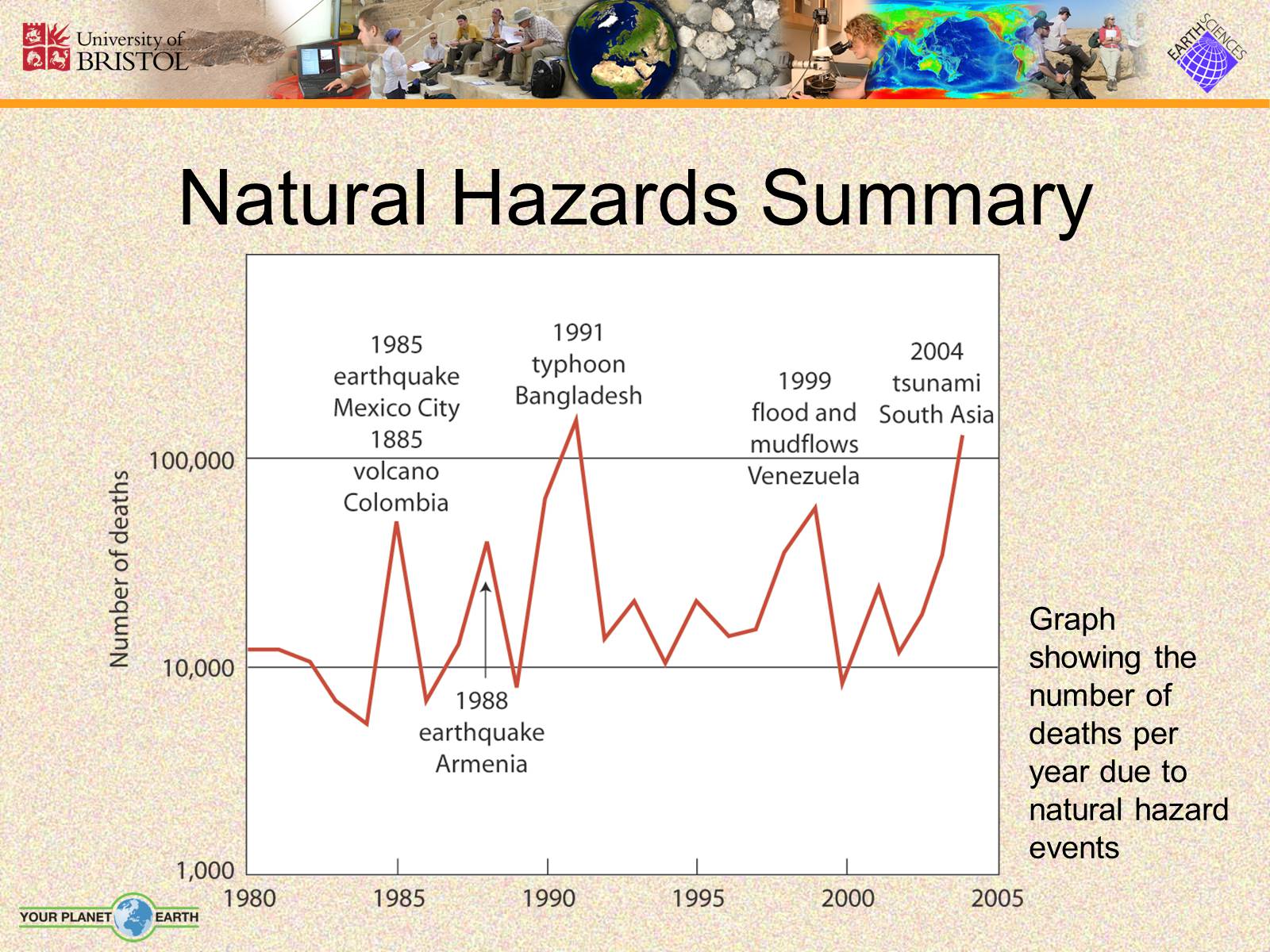- Головна
- Готові шкільні презентації
- Презентація на тему «Natural Hazards»
Презентація на тему «Natural Hazards»
340
Слайд #1
Presentation: “Natural Hazards”
Prepared by
Oleksandra Pekhn'o
Form 11-A
School of Chynadiievo
Prepared by
Oleksandra Pekhn'o
Form 11-A
School of Chynadiievo
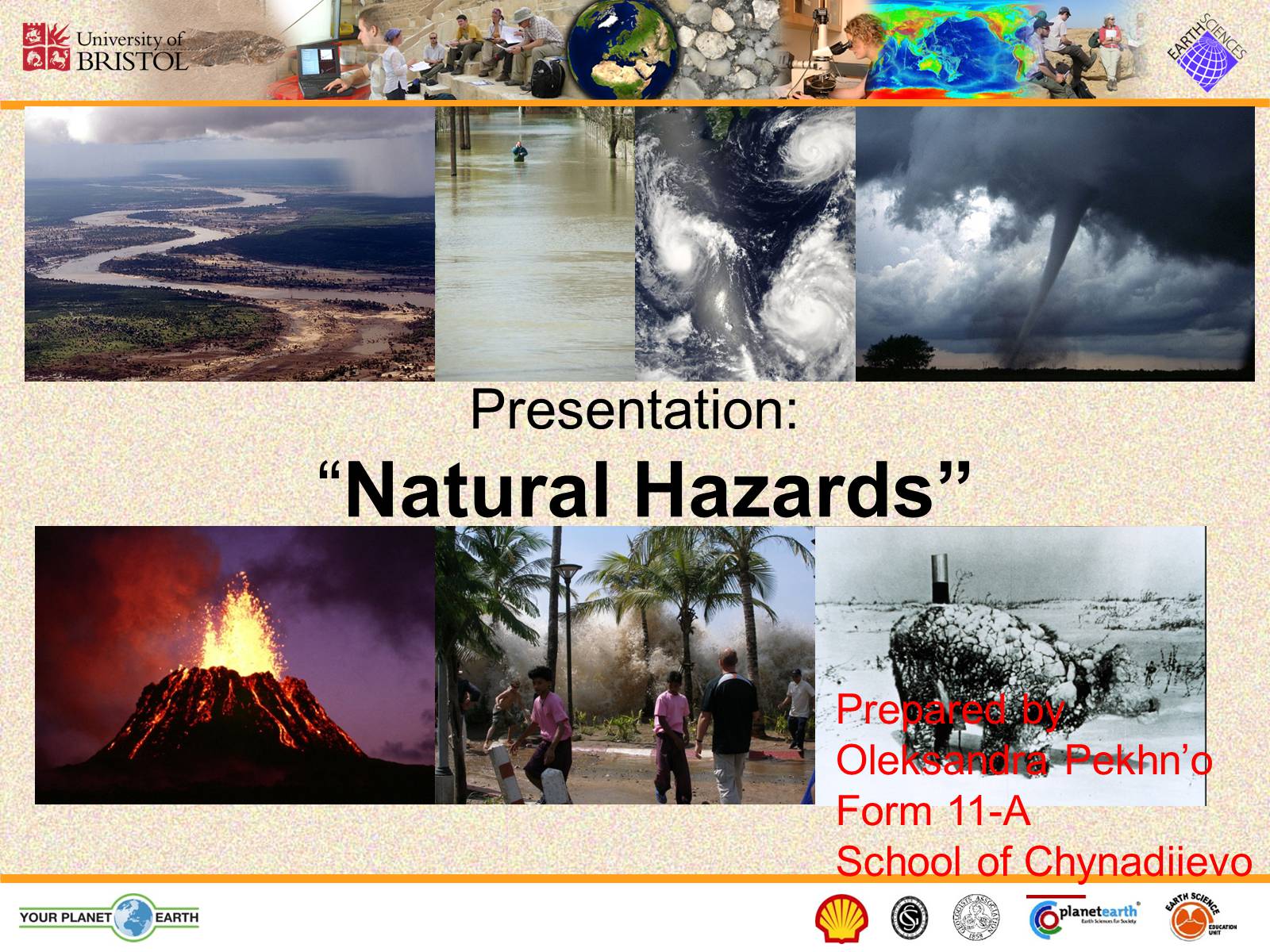
Слайд #2
Introduction to Natural Hazards
What is a “Geohazard”?
Earth processes (involving the lithosphere, hydrosphere & atmosphere) that, upon interaction with human activity, cause loss of life and property
It is important to understand the human element
without it, there would be no hazard
because of it, the science of geohazards becomes more important every year
mitigation: reduction/prevention
geo-process
humanprocess
Hazardousconditionor result
What is a “Geohazard”?
Earth processes (involving the lithosphere, hydrosphere & atmosphere) that, upon interaction with human activity, cause loss of life and property
It is important to understand the human element
without it, there would be no hazard
because of it, the science of geohazards becomes more important every year
mitigation: reduction/prevention
geo-process
humanprocess
Hazardousconditionor result
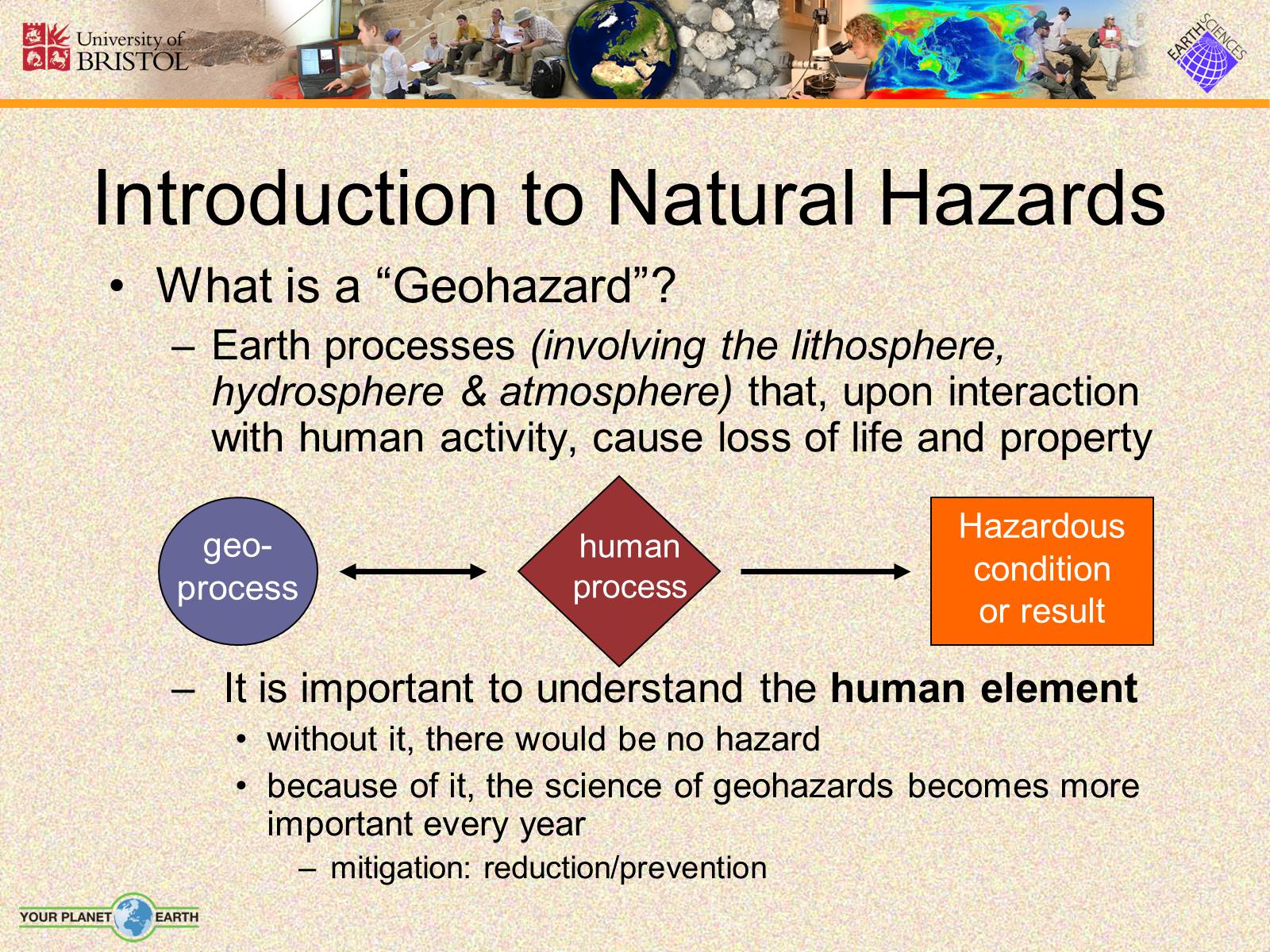
Слайд #3
The Earth's population is increasing
more people living in hazard-prone areas
populations are becoming hyper-concentrated
consumption of resources
examples:
today there are 6 billion people on Earth ( ~ 50% live in cities)
by 2025, there will be ~8 billion people (~ 66% in cities)
of these cities, 40% are coastal
prone to severe storm and tsunami damage
and a large majority lie in areas subject to other geohazards (for example volcanoes and earthquakes)
Why is the human element so critical?
more people living in hazard-prone areas
populations are becoming hyper-concentrated
consumption of resources
examples:
today there are 6 billion people on Earth ( ~ 50% live in cities)
by 2025, there will be ~8 billion people (~ 66% in cities)
of these cities, 40% are coastal
prone to severe storm and tsunami damage
and a large majority lie in areas subject to other geohazards (for example volcanoes and earthquakes)
Why is the human element so critical?
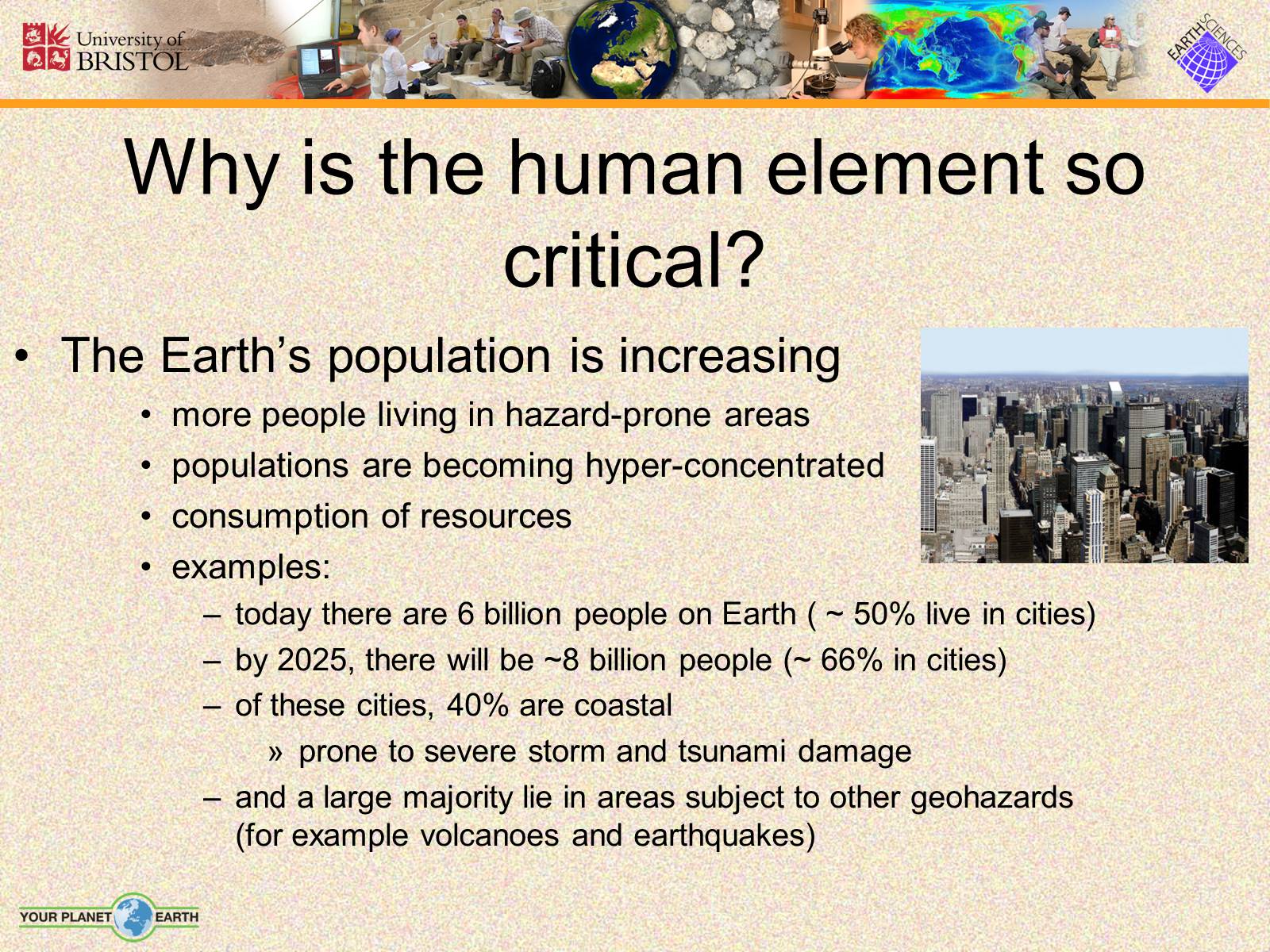
Слайд #4
The Earth's population is increasing
more people living in hazard-prone areas
populations are becoming hyper-concentrated
consumption of resources
examples:
today there are 6 billion people on Earth ( ~ 50% live in cities)
by 2025, there will be ~8 billion people (~ 66% in cities)
of these cities, 40% are coastal
prone to severe storm and tsunami damage
and a large majority lie in areas subject to other geohazards (for example volcanoes and earthquakes)
Why is the human element so critical?
more people living in hazard-prone areas
populations are becoming hyper-concentrated
consumption of resources
examples:
today there are 6 billion people on Earth ( ~ 50% live in cities)
by 2025, there will be ~8 billion people (~ 66% in cities)
of these cities, 40% are coastal
prone to severe storm and tsunami damage
and a large majority lie in areas subject to other geohazards (for example volcanoes and earthquakes)
Why is the human element so critical?
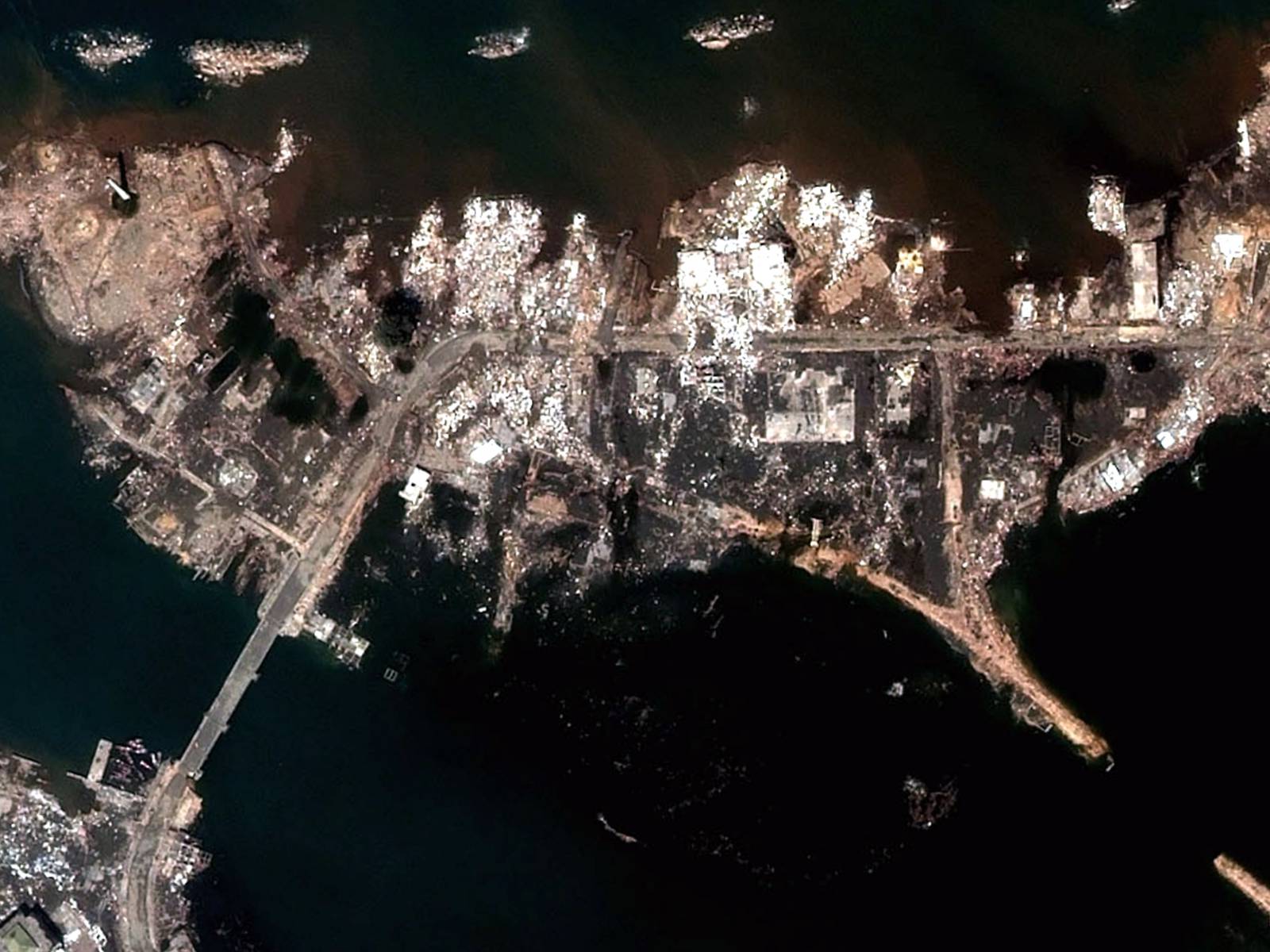
Слайд #5
CANNOT stop the geologic processes
CANNOT stop the population growth/expansion
Therefore, we must try to reduce (mitigate) the hazards through:
scientific study
population education
changes in engineering/building practices
management plans and hazard response scenarios
CANNOT stop the population growth/expansion
Therefore, we must try to reduce (mitigate) the hazards through:
scientific study
population education
changes in engineering/building practices
management plans and hazard response scenarios
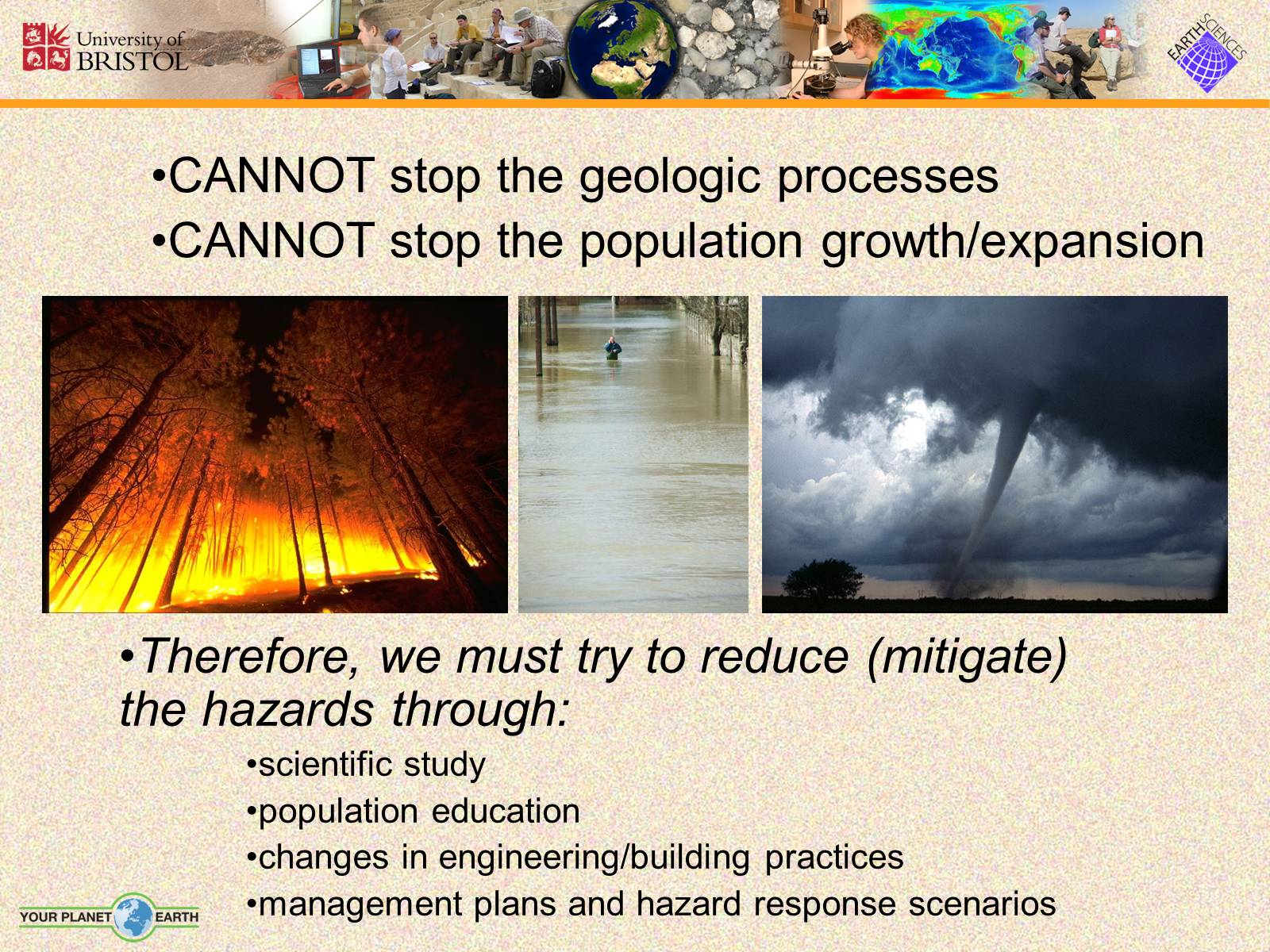
Слайд #6
Earthquakes and Tsunamis
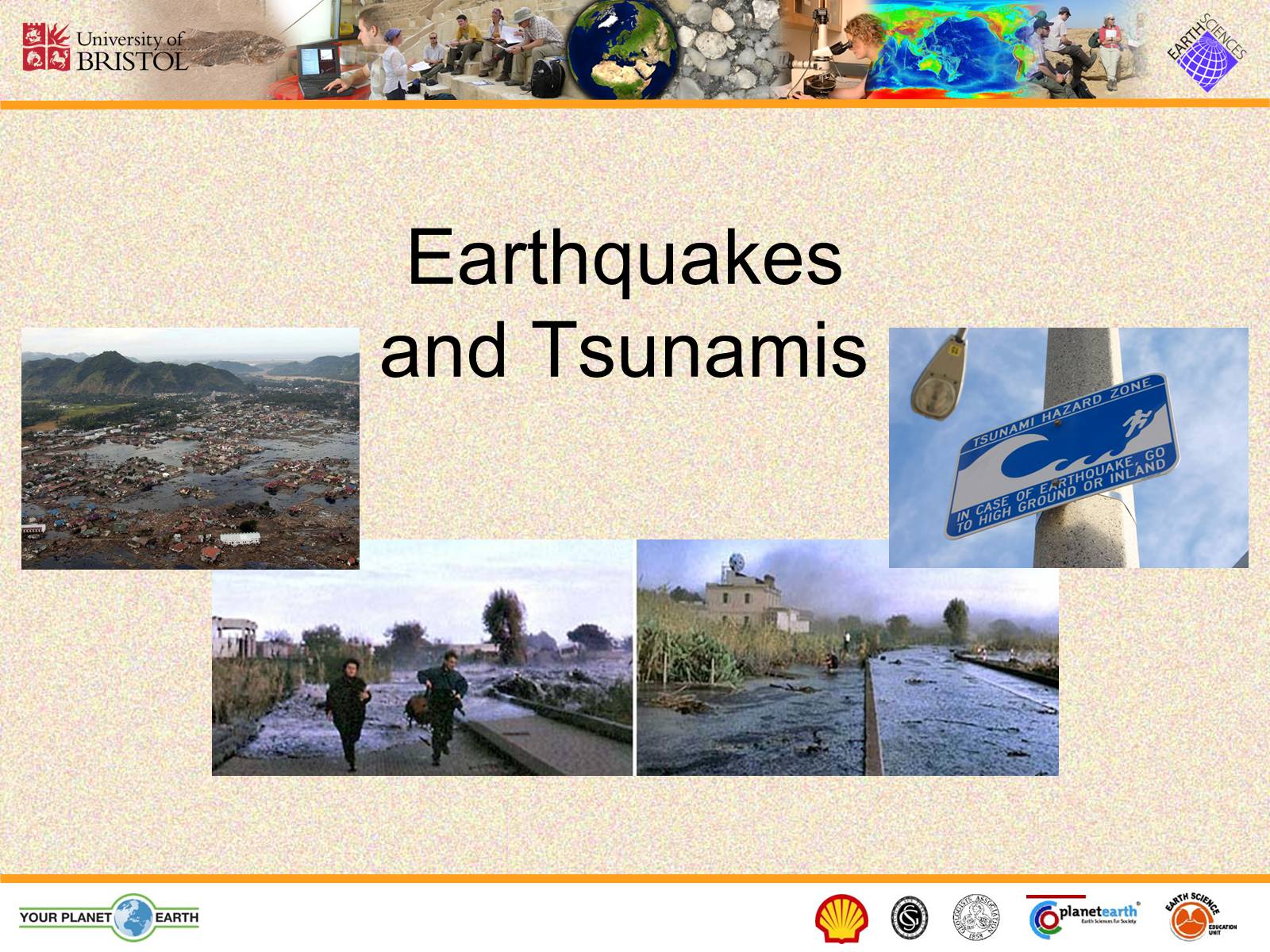
Слайд #7
San Francisco - Great Earthquake
Magnitude 7.7 - 8.3
Magnitude 7.7 - 8.3
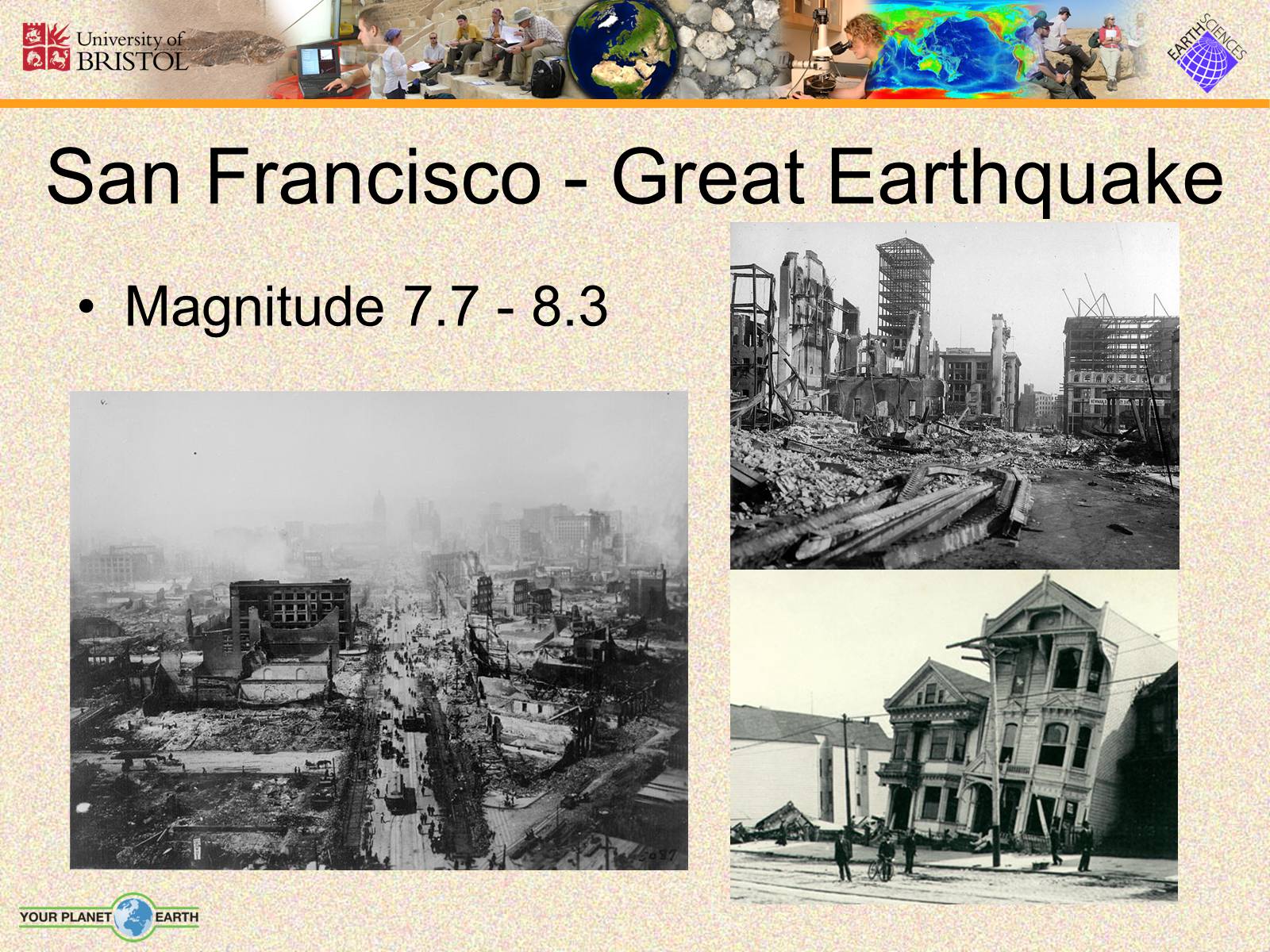
Слайд #8
Earthquake Hazards
These are important hazards to understand:
the natural hazard that on average kills the highest number of people per year (> 1 million during the past century)
commonly strikes without warning
no time for evacuation
not a predictable trend to earthquake numbers, magnitude or location
1000's of large earthquakes every year
~ 20 are > M7.0 and these account for 90% of the energy released and 80% of all the fatalities
These are important hazards to understand:
the natural hazard that on average kills the highest number of people per year (> 1 million during the past century)
commonly strikes without warning
no time for evacuation
not a predictable trend to earthquake numbers, magnitude or location
1000's of large earthquakes every year
~ 20 are > M7.0 and these account for 90% of the energy released and 80% of all the fatalities
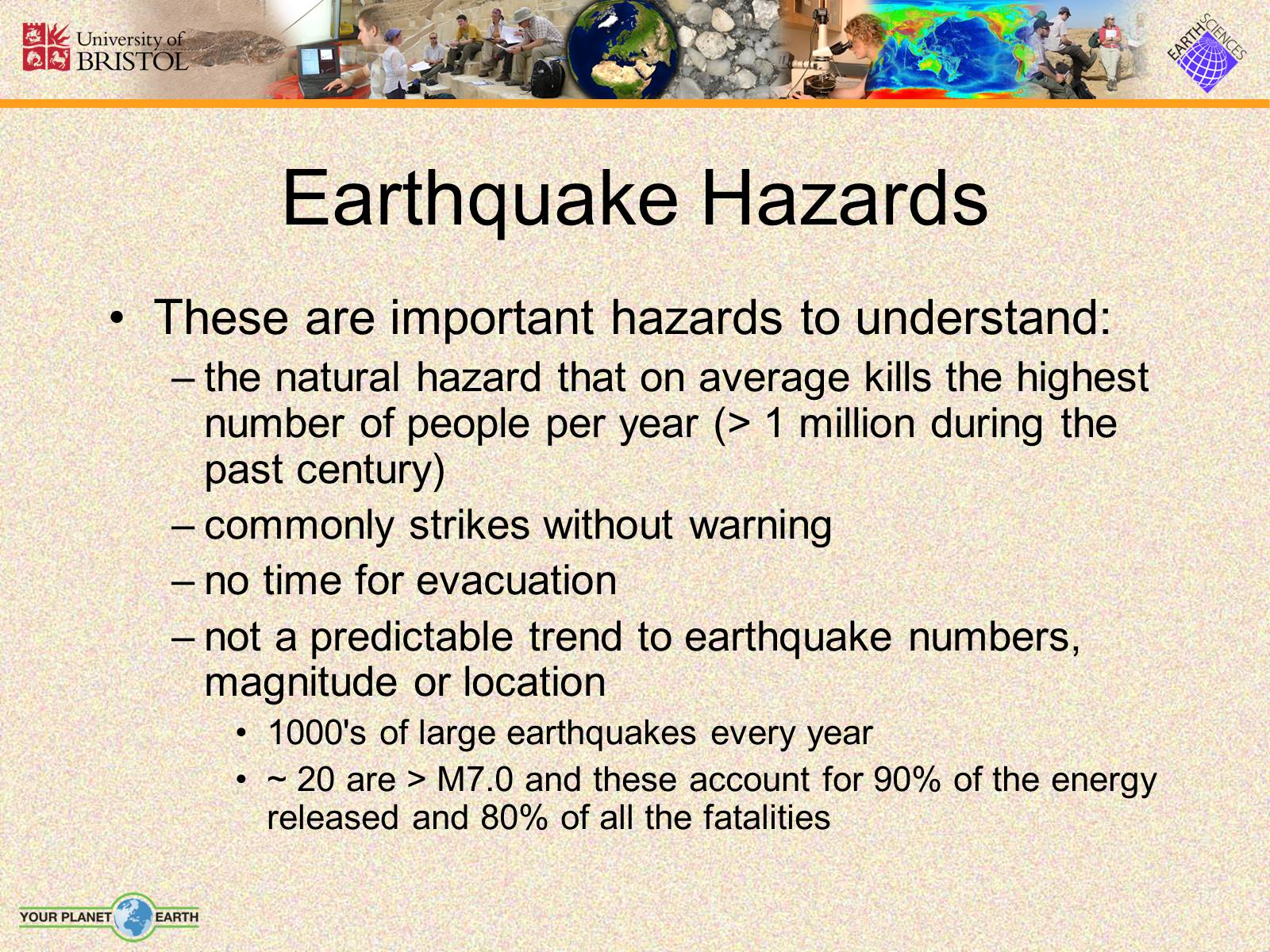
Слайд #9
Earthquake Hazards
These are important hazards to understand:
the natural hazard that on average kills the highest number of people per year (> 1 million during the past century)
commonly strikes without warning
no time for evacuation
not a predictable trend to earthquake numbers, magnitude or location
1000's of large earthquakes every year
~ 20 are > M7.0 and these account for 90% of the energy released and 80% of all the fatalities
These are important hazards to understand:
the natural hazard that on average kills the highest number of people per year (> 1 million during the past century)
commonly strikes without warning
no time for evacuation
not a predictable trend to earthquake numbers, magnitude or location
1000's of large earthquakes every year
~ 20 are > M7.0 and these account for 90% of the energy released and 80% of all the fatalities
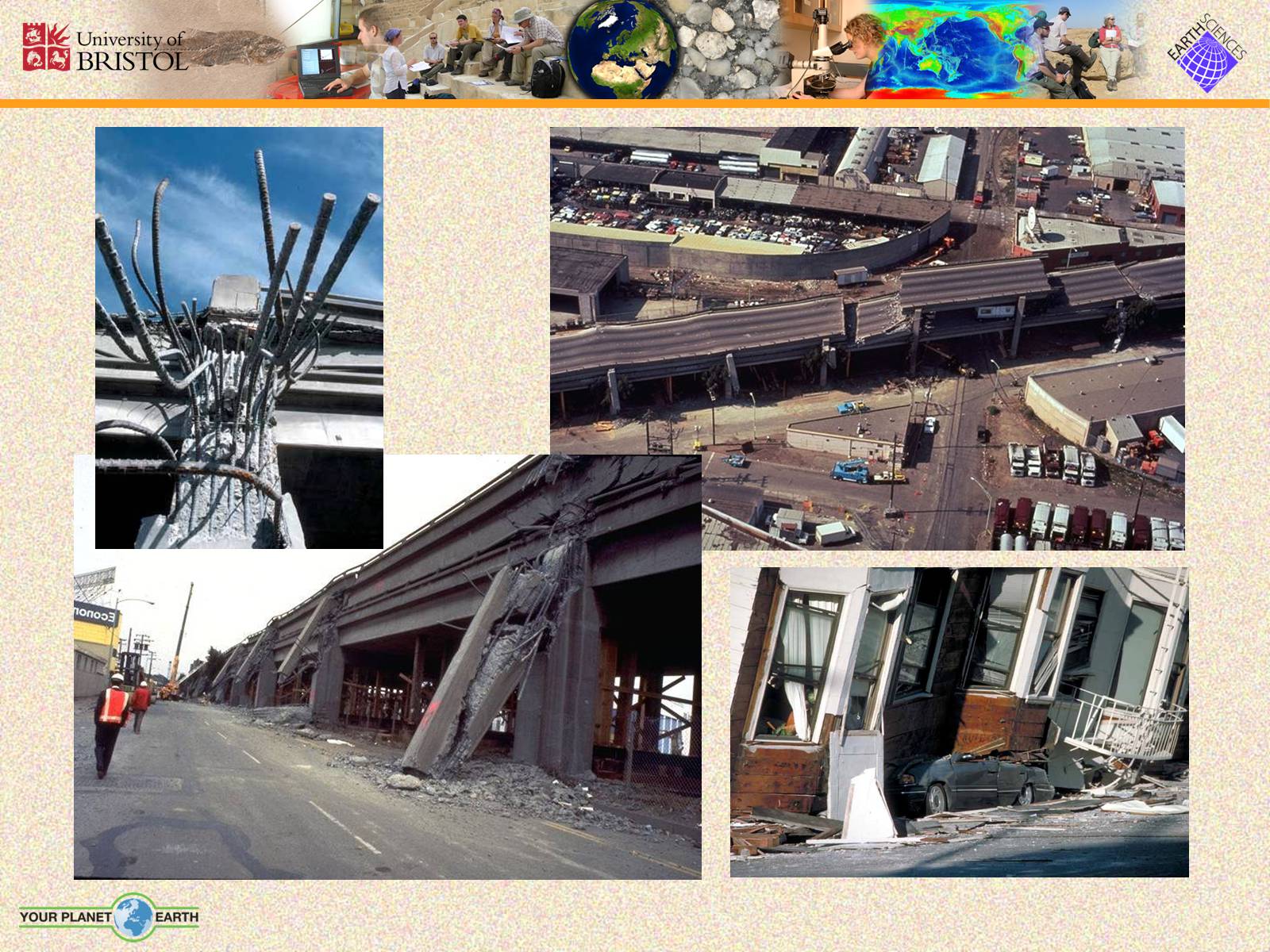
Слайд #10
How do we mitigate the hazard from earthquakes?
Reinforce buildings
Education
Disaster plan
Reinforce buildings
Education
Disaster plan
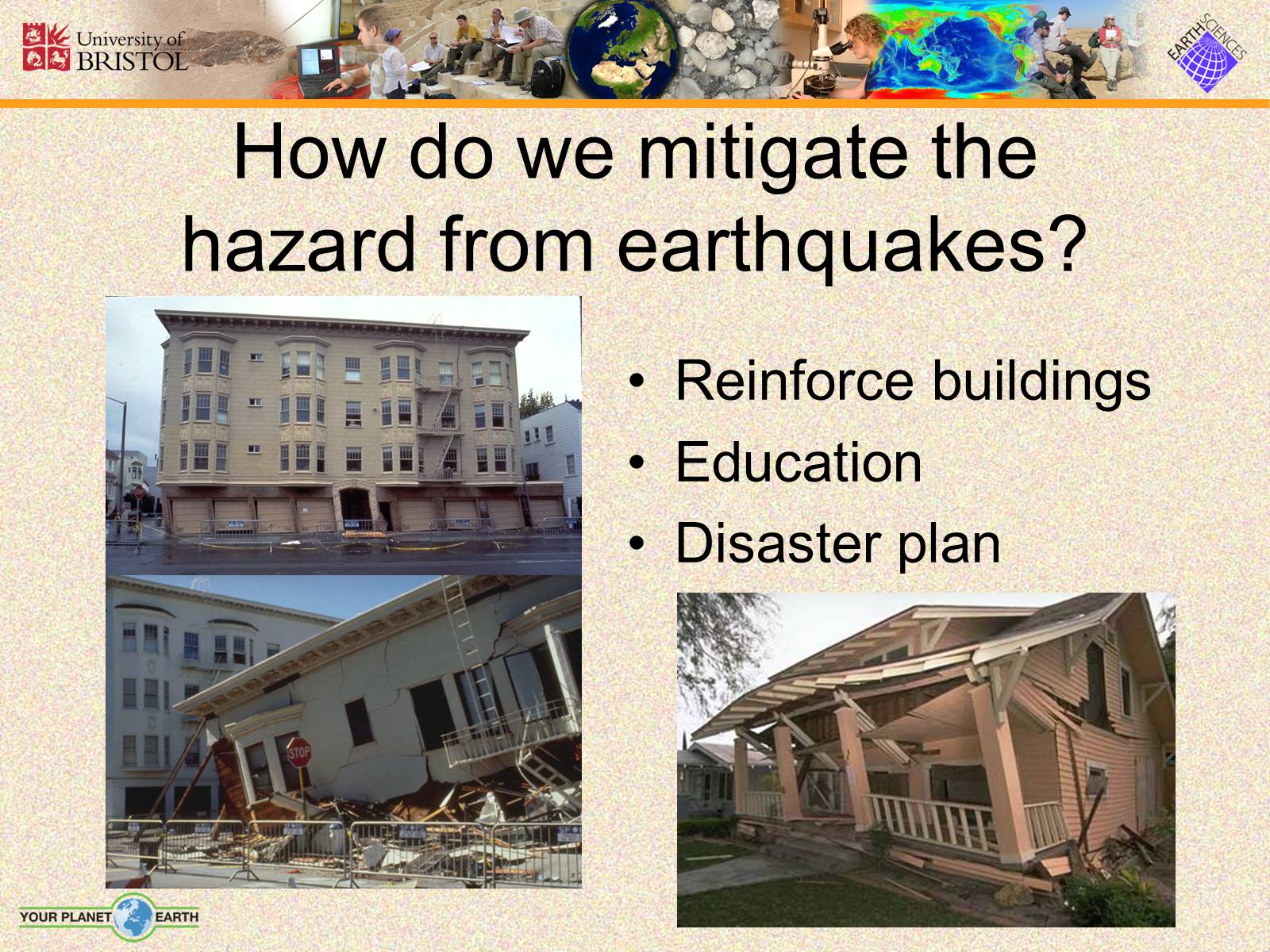
Слайд #11
Earthquakes and Tsunami's
An earthquake under the ocean has the potential to form a tsunami.
The earthquake must vertically displace overlying water (extensional or compressional faults - not transform)
Extension
Compression
Transform
An earthquake under the ocean has the potential to form a tsunami.
The earthquake must vertically displace overlying water (extensional or compressional faults - not transform)
Extension
Compression
Transform
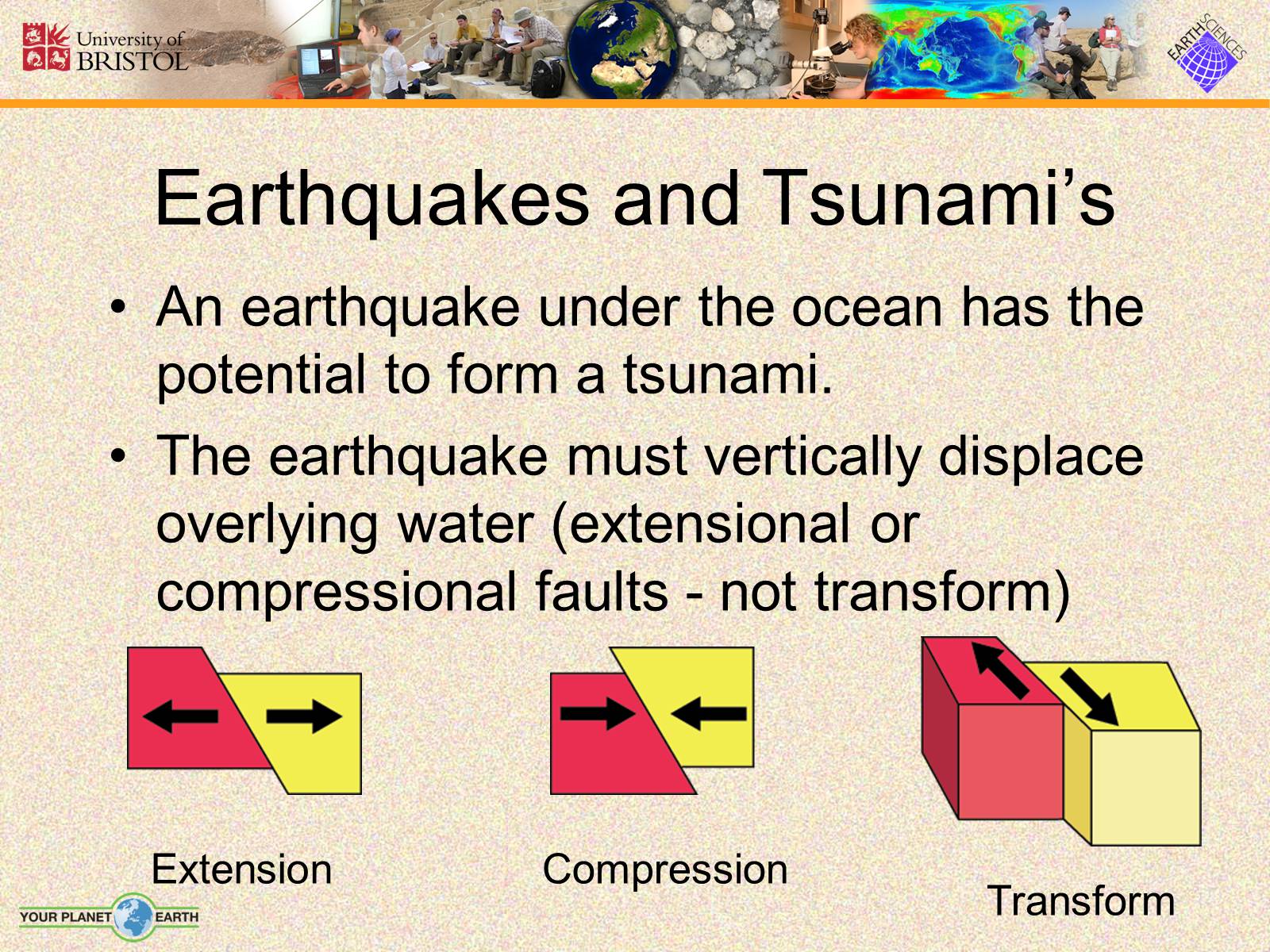
Слайд #12
How does an earthquake form a tsunami?
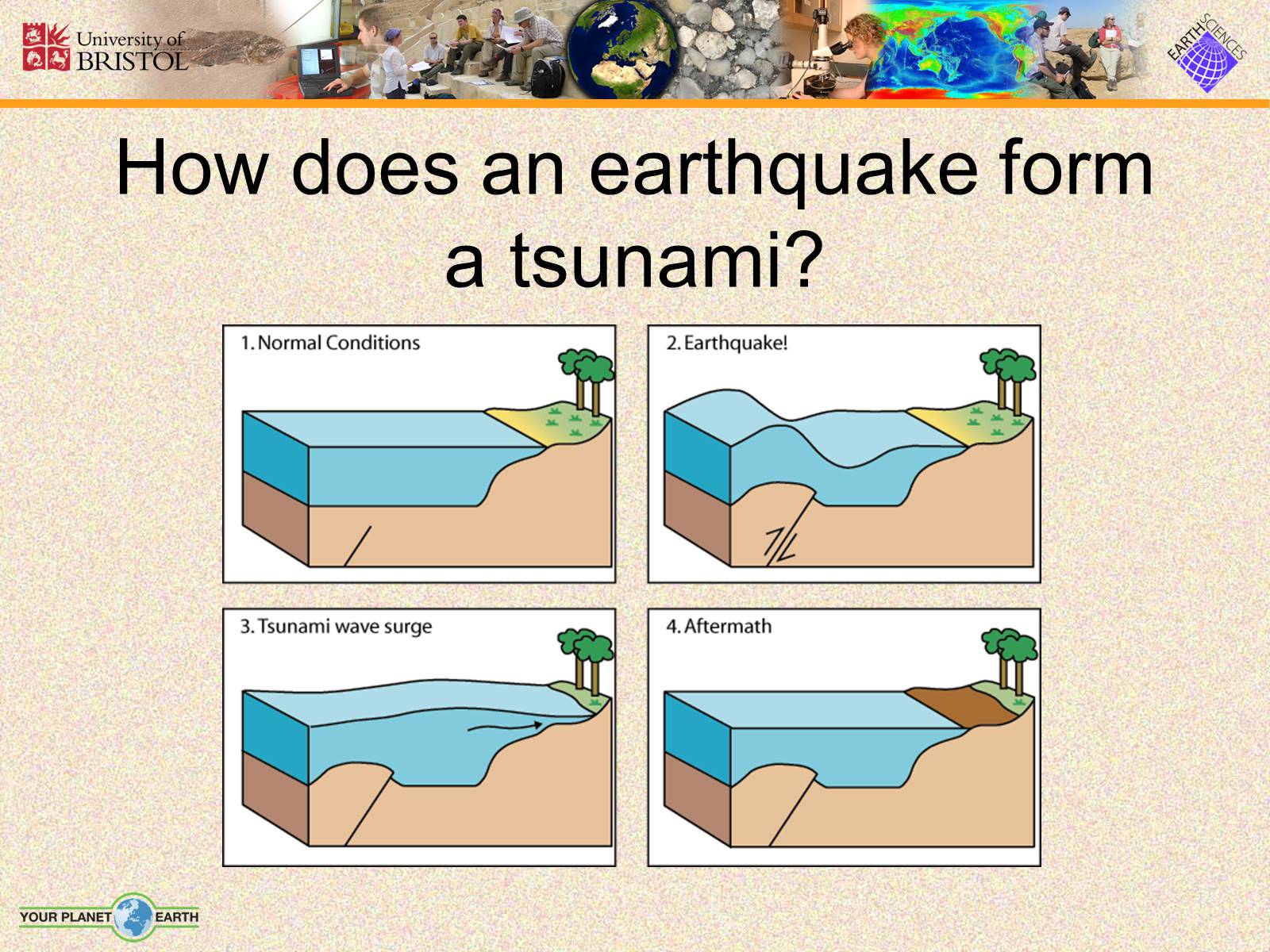
Слайд #13
2004 South Asian Boxing Day event
Biggest earthquake in 40 years!
Magnitude 9.2
150 km off the west of Northern Sumatra
Generated a disastrous tsunami in 12 countries
Biggest earthquake in 40 years!
Magnitude 9.2
150 km off the west of Northern Sumatra
Generated a disastrous tsunami in 12 countries
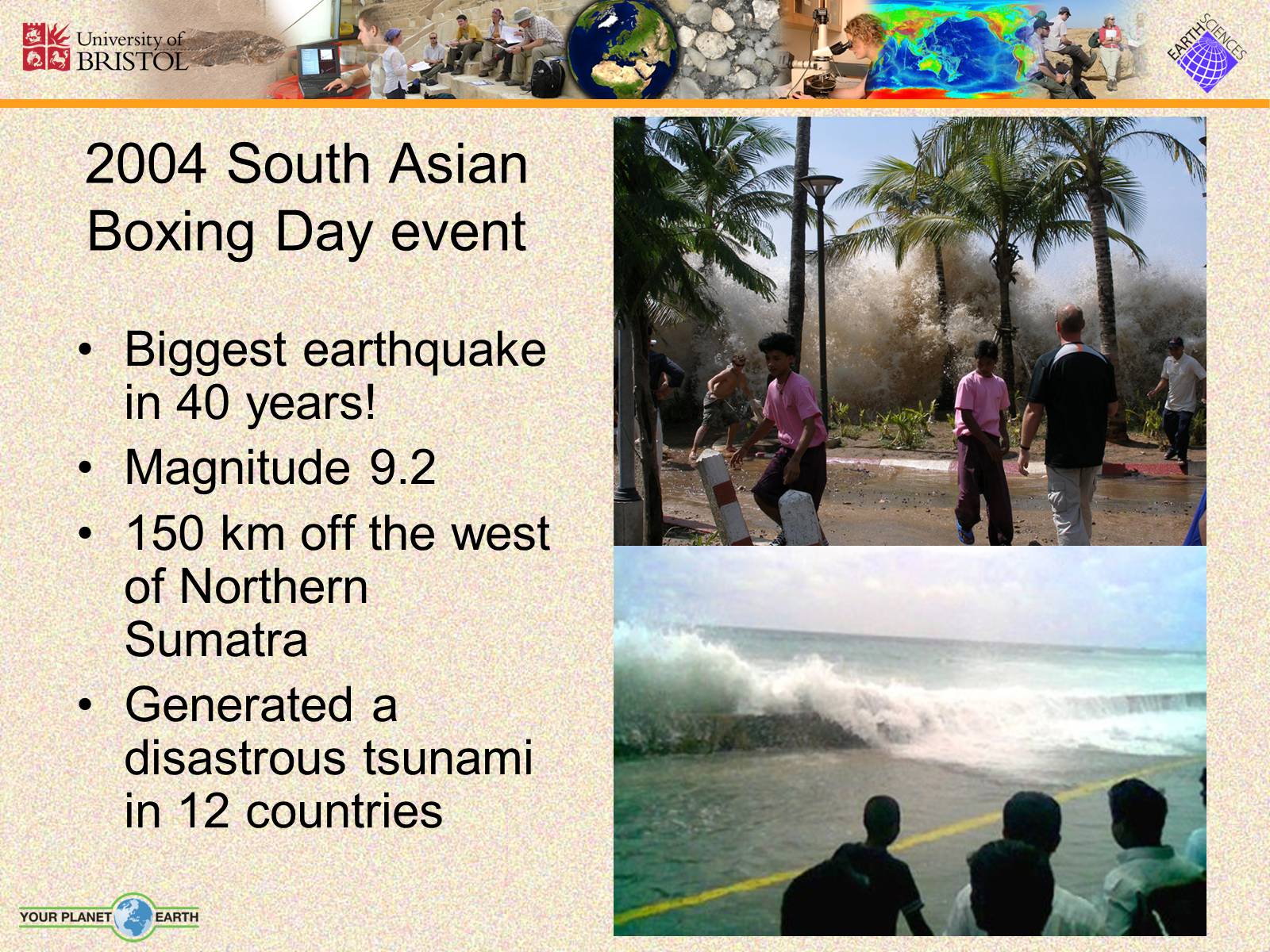
Слайд #14
The earthquake occurred at a convergent tectonic plate boundary (subduction zone)
An estimated 1,600 km (994 miles) of faultline slipped about 15 m (50 ft)!
The earthquake released 20 x 1017 Joules of energy
Equivalent to:
475,000,000 kg of TNT
23,000 Hiroshima atomic bombs!
Second largest recorded earthquake
An estimated 1,600 km (994 miles) of faultline slipped about 15 m (50 ft)!
The earthquake released 20 x 1017 Joules of energy
Equivalent to:
475,000,000 kg of TNT
23,000 Hiroshima atomic bombs!
Second largest recorded earthquake
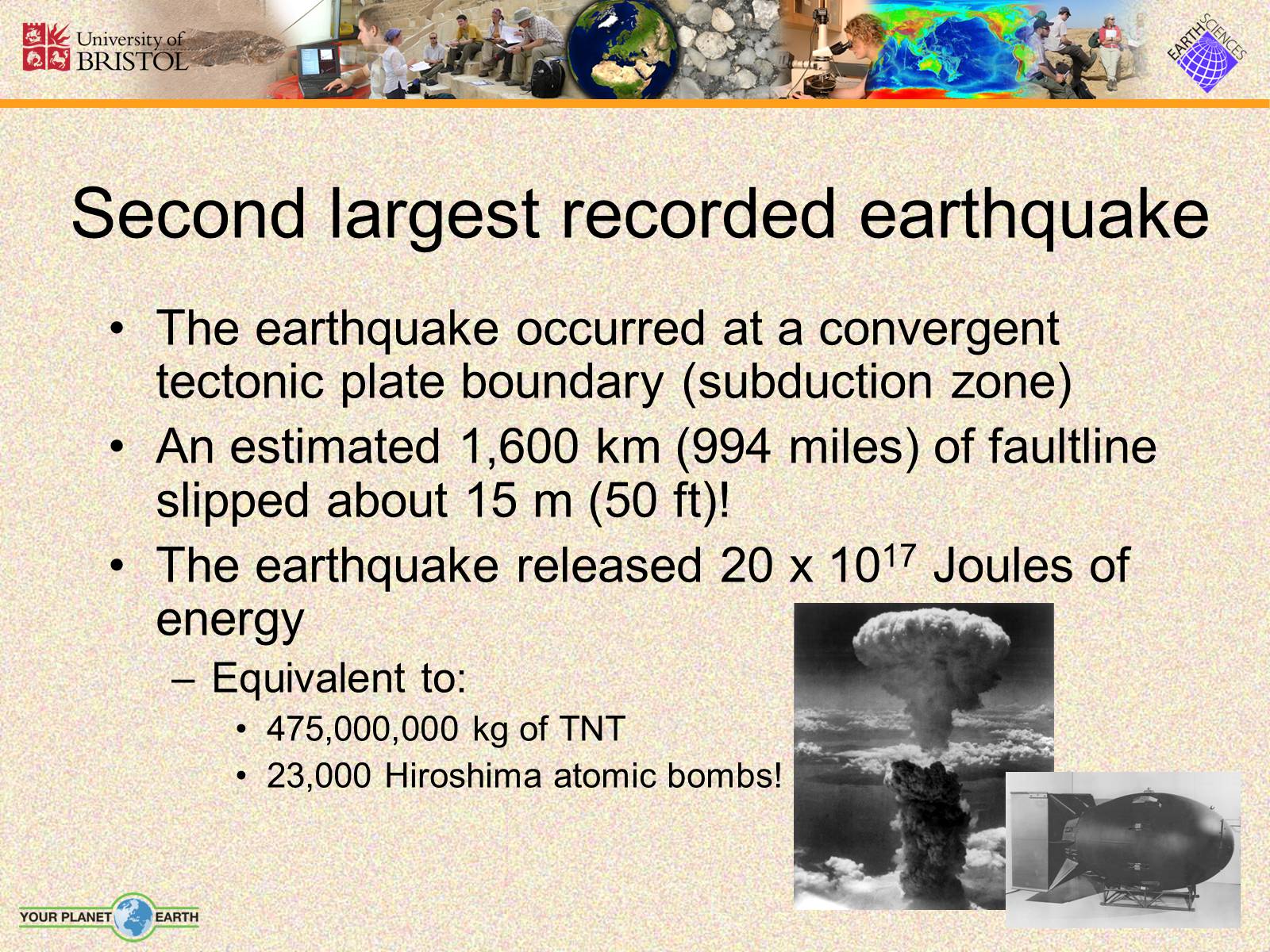
Слайд #15
A village near the coast of Sumatra lays in ruin after the tsunami.
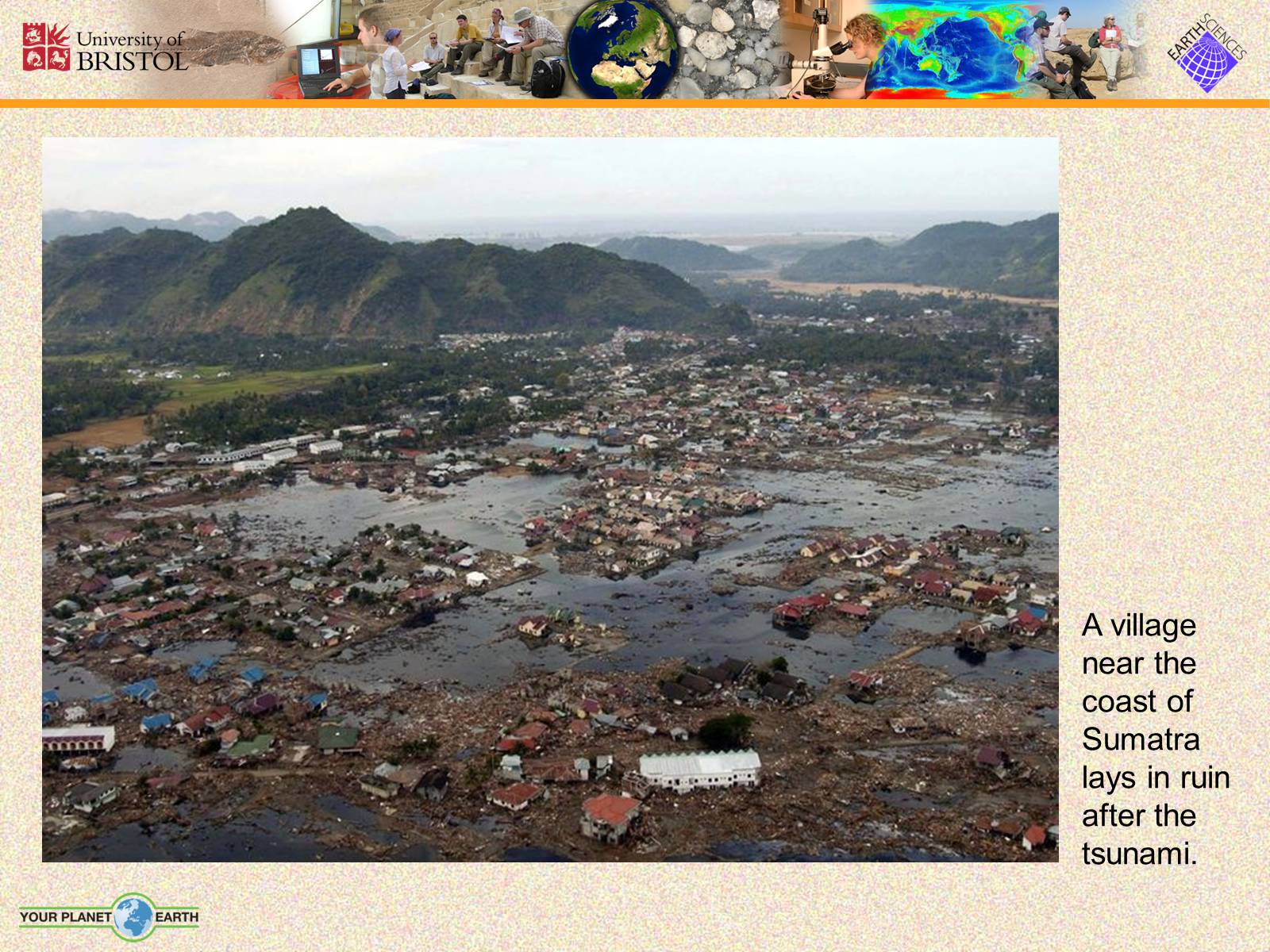
Слайд #16
How do we mitigate the hazard from tsunamis?
Monitoring
process is very technology-intensive
high costs for many poorer countries
often no technology available to monitor local tsunamis
for example,
Papua New Guinea has no monitoring stations
reliant on the Pacific Tsunami Warning Center
tsunami in 1998 was not detected
Monitoring
process is very technology-intensive
high costs for many poorer countries
often no technology available to monitor local tsunamis
for example,
Papua New Guinea has no monitoring stations
reliant on the Pacific Tsunami Warning Center
tsunami in 1998 was not detected
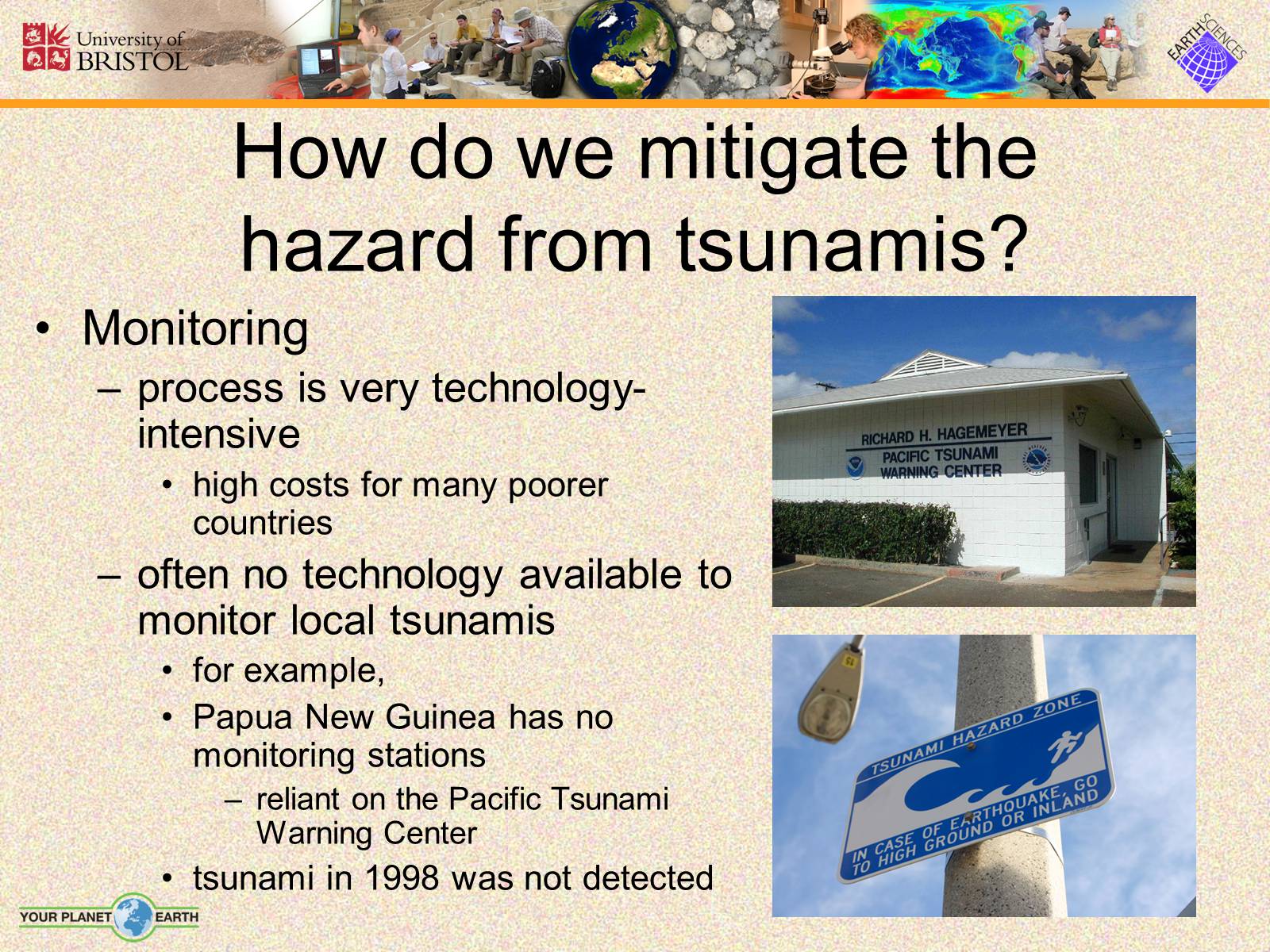
Слайд #17
Seawall construction
cause early wave breaking
prevent wave run up into urban areas
How do we mitigate the hazard from tsunamis?
cause early wave breaking
prevent wave run up into urban areas
How do we mitigate the hazard from tsunamis?
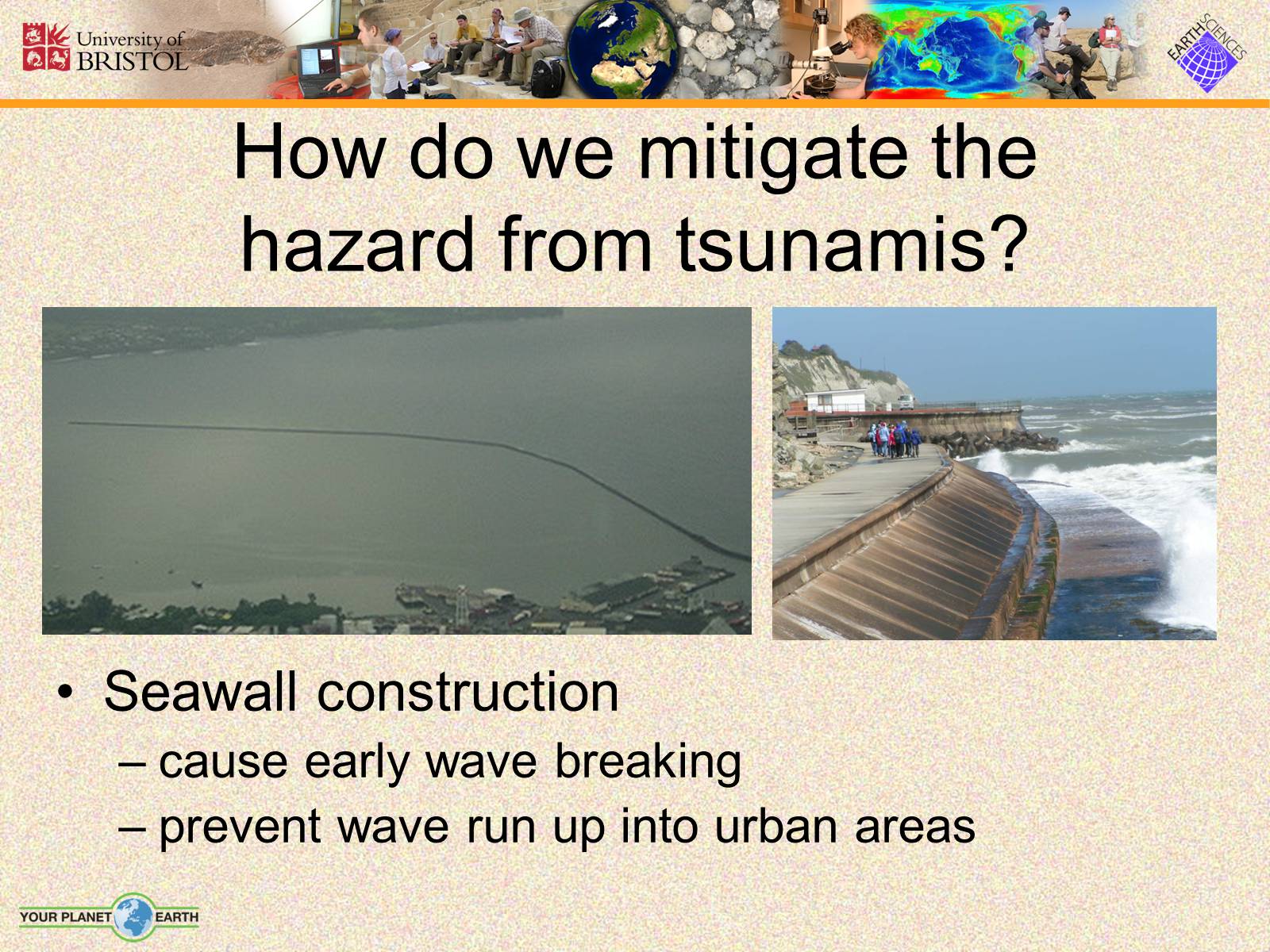
Слайд #18
Education
warning systems
evacuation plans
general understanding of the hazards involved
Punishment
From God
45%
Natural event
35%
Bomb 20%
Population reaction: Papua New Guinea (1998)
How do we mitigate the hazard from tsunamis?
warning systems
evacuation plans
general understanding of the hazards involved
Punishment
From God
45%
Natural event
35%
Bomb 20%
Population reaction: Papua New Guinea (1998)
How do we mitigate the hazard from tsunamis?
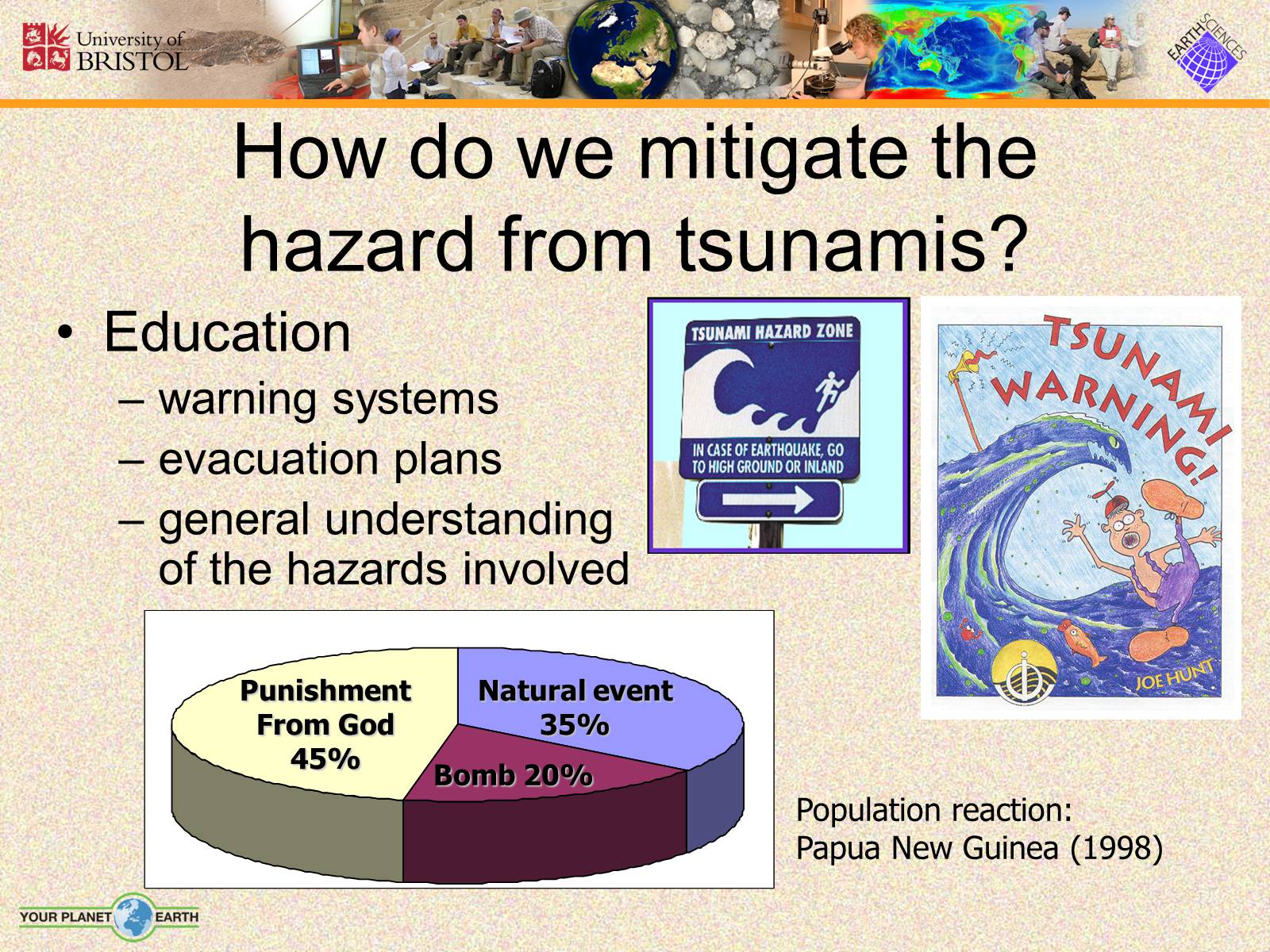
Слайд #19
Tropical Storms
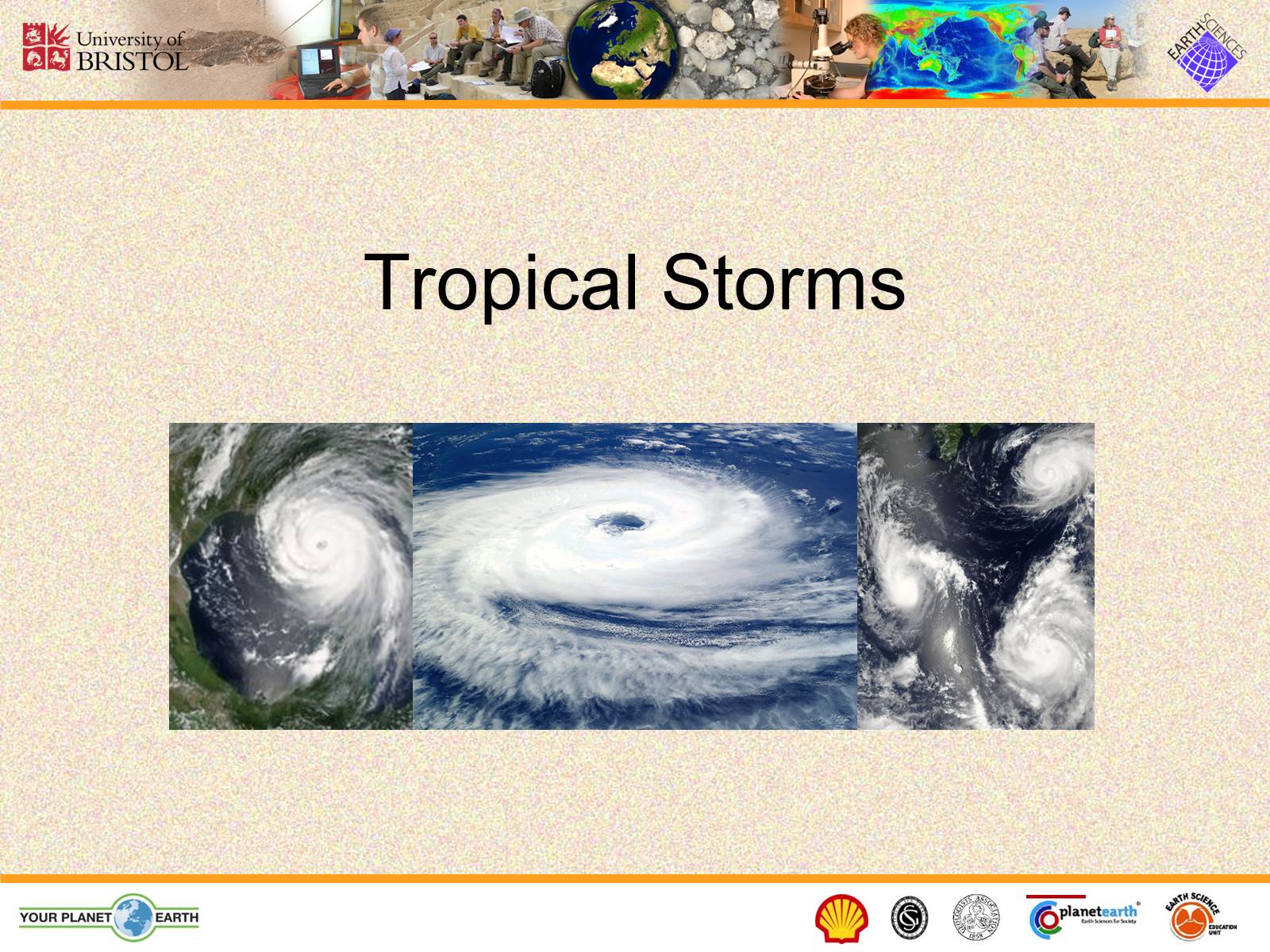
Слайд #20
Same Storm - Different Name
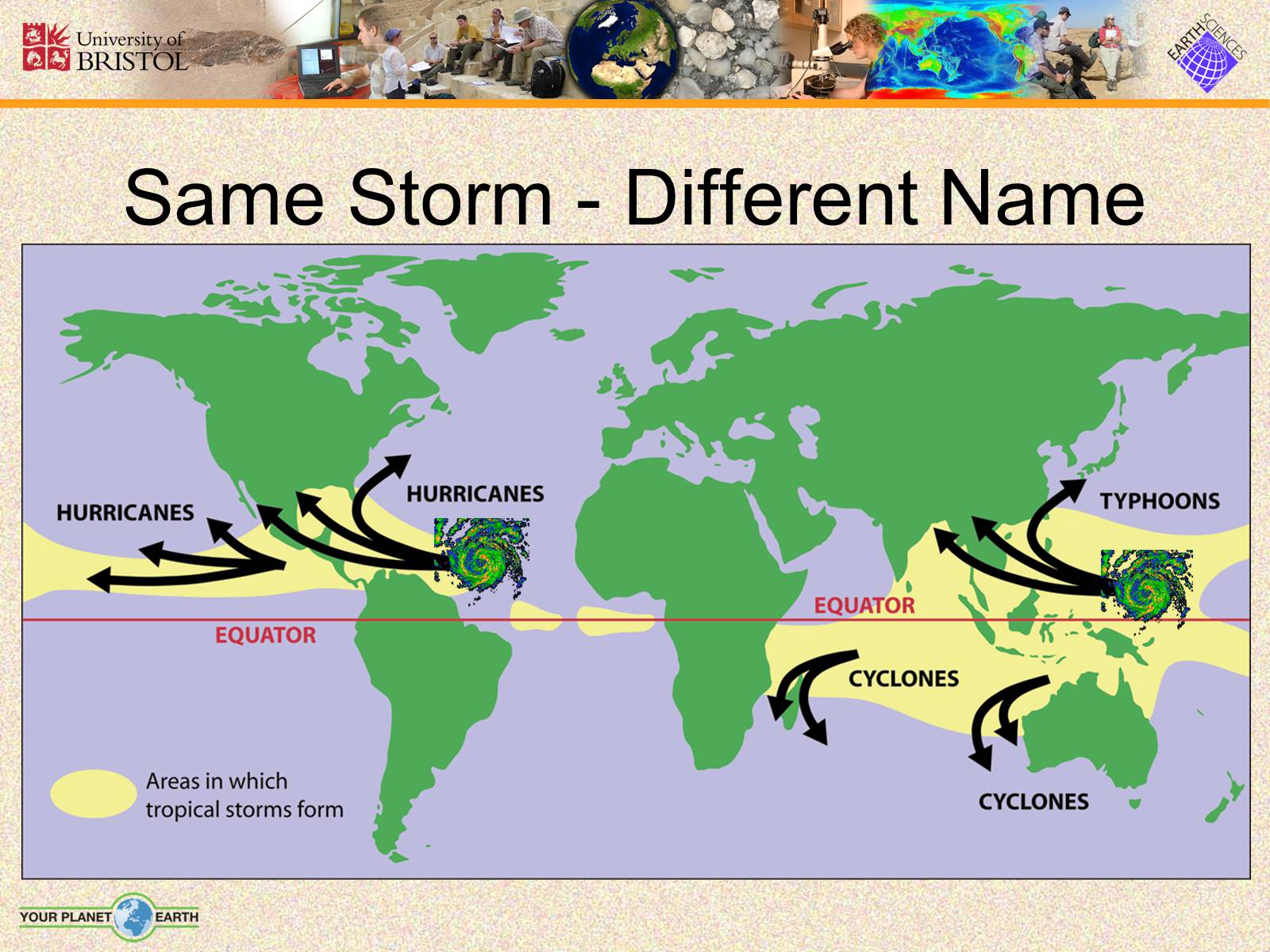
Слайд #21
Most widespread destructive weather hazard
For example: Hurricane Floyd (1999)
only a moderate level hurricane
caused US$5.6 billion in damage in the Bahamas and North Carolina (USA) and 57 fatalities
Tropical Cyclones
(Left) Three different cyclones spinning over the western Pacific Ocean on August 7, 2006.
For example: Hurricane Floyd (1999)
only a moderate level hurricane
caused US$5.6 billion in damage in the Bahamas and North Carolina (USA) and 57 fatalities
Tropical Cyclones
(Left) Three different cyclones spinning over the western Pacific Ocean on August 7, 2006.
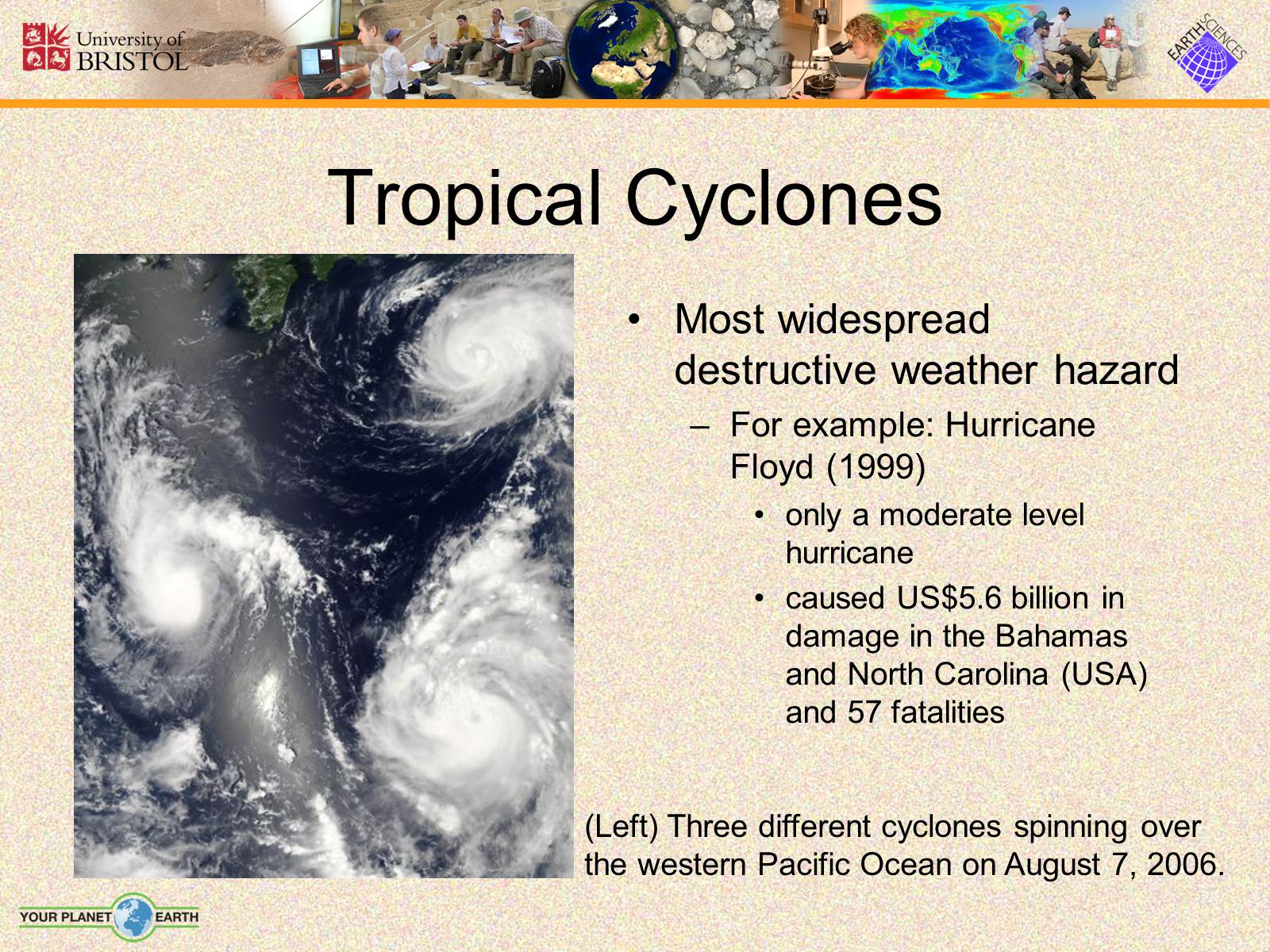
Слайд #22
How do cyclones form?
The above figure shows how cyclones form. The green arrows show where warm air is rising. The red arrows indicate where cool air is sinking.
The above figure shows how cyclones form. The green arrows show where warm air is rising. The red arrows indicate where cool air is sinking.
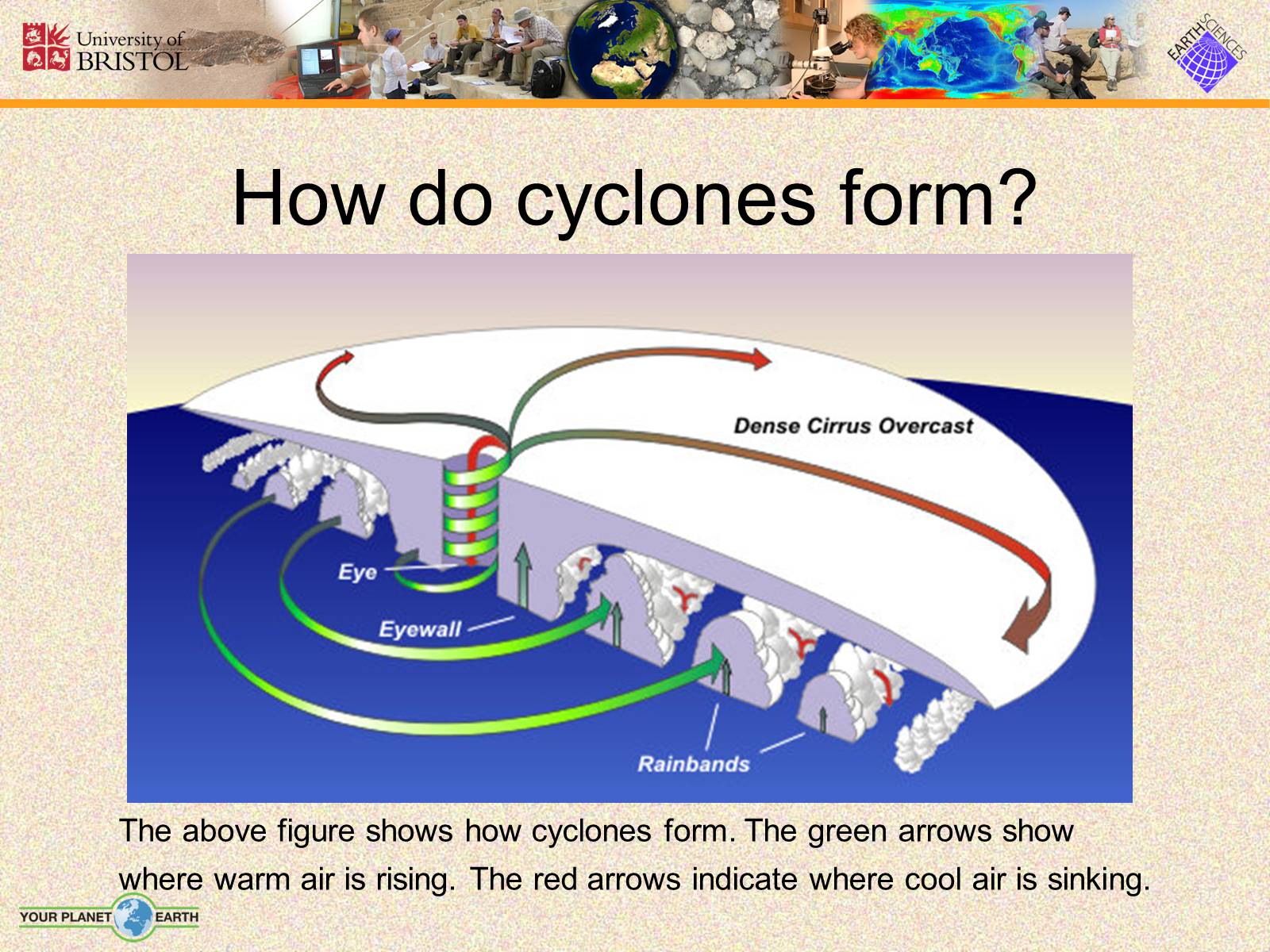
Слайд #23
Cyclone Categories
Category
Wind Speed (mph)
Damage at Landfall
Storm Surge (feet)
1
74-95
Minimal
4-5
2
96-110
Moderate
6-8
3
111-130
Extensive
9-12
4
131-155
Extreme
13-18
5
> 155
Catastrophic
19+
The Saffir-Simpson Hurricane Scale
Category
Wind Speed (mph)
Damage at Landfall
Storm Surge (feet)
1
74-95
Minimal
4-5
2
96-110
Moderate
6-8
3
111-130
Extensive
9-12
4
131-155
Extreme
13-18
5
> 155
Catastrophic
19+
The Saffir-Simpson Hurricane Scale
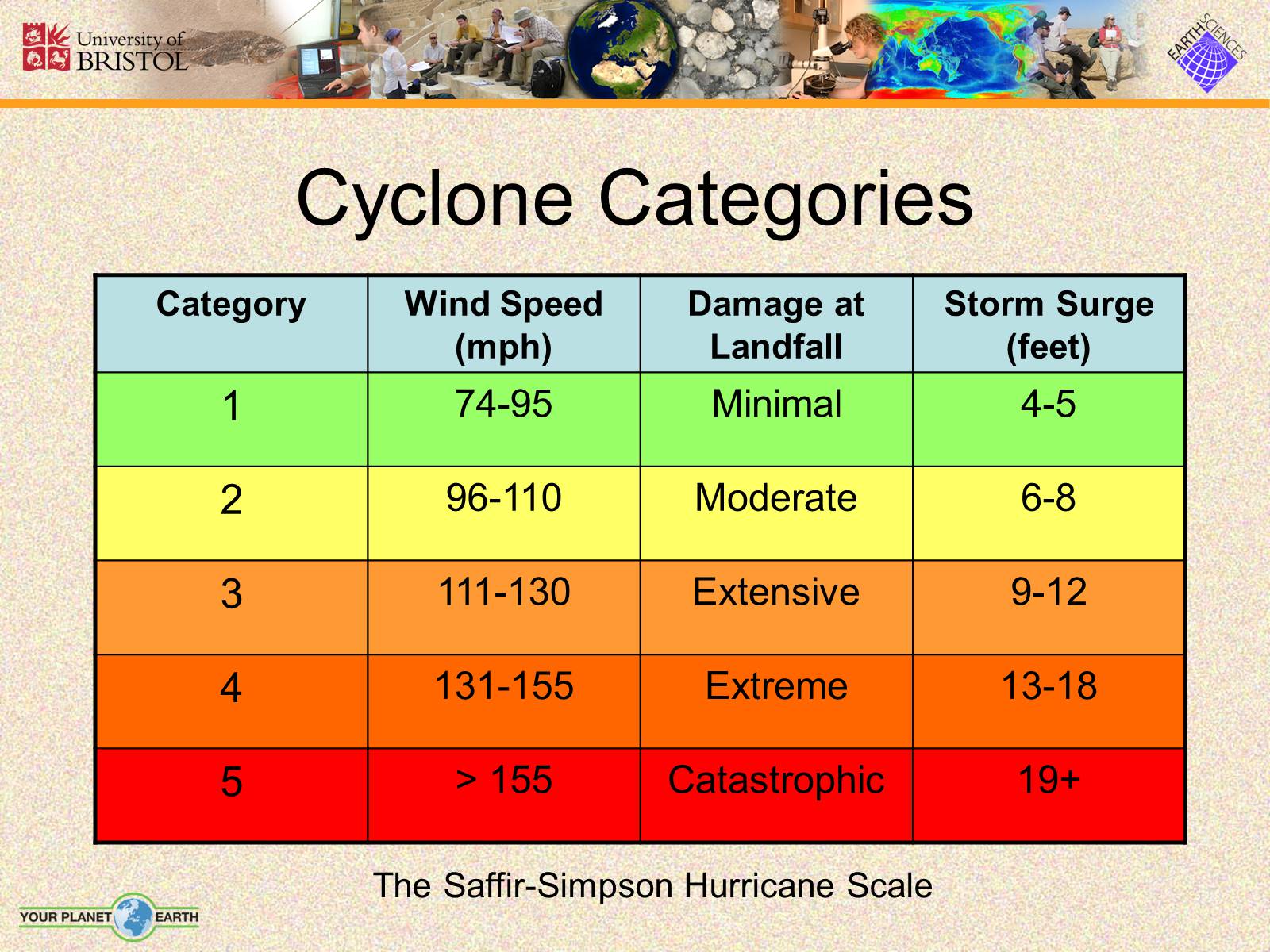
Слайд #24
Hurricane Katrina
Hurricane Katrina was the most costly and most deadly hurricane in the history of the USA.
Category 5
At least 1,836 fatalities
Damage estimated at US$ 81.2 billion
Hurricane Katrina was the most costly and most deadly hurricane in the history of the USA.
Category 5
At least 1,836 fatalities
Damage estimated at US$ 81.2 billion
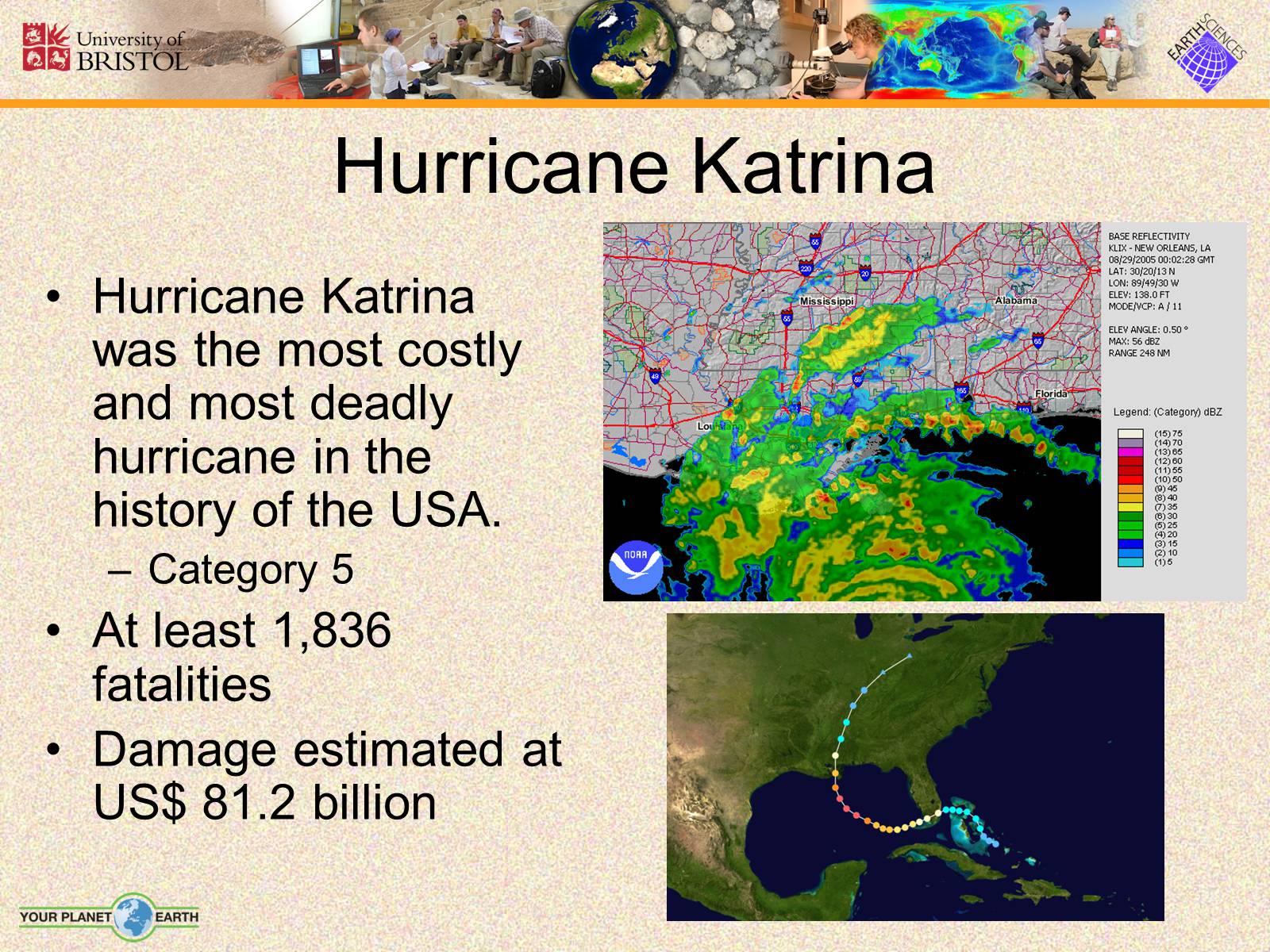
Слайд #25
Hurricane Katrina
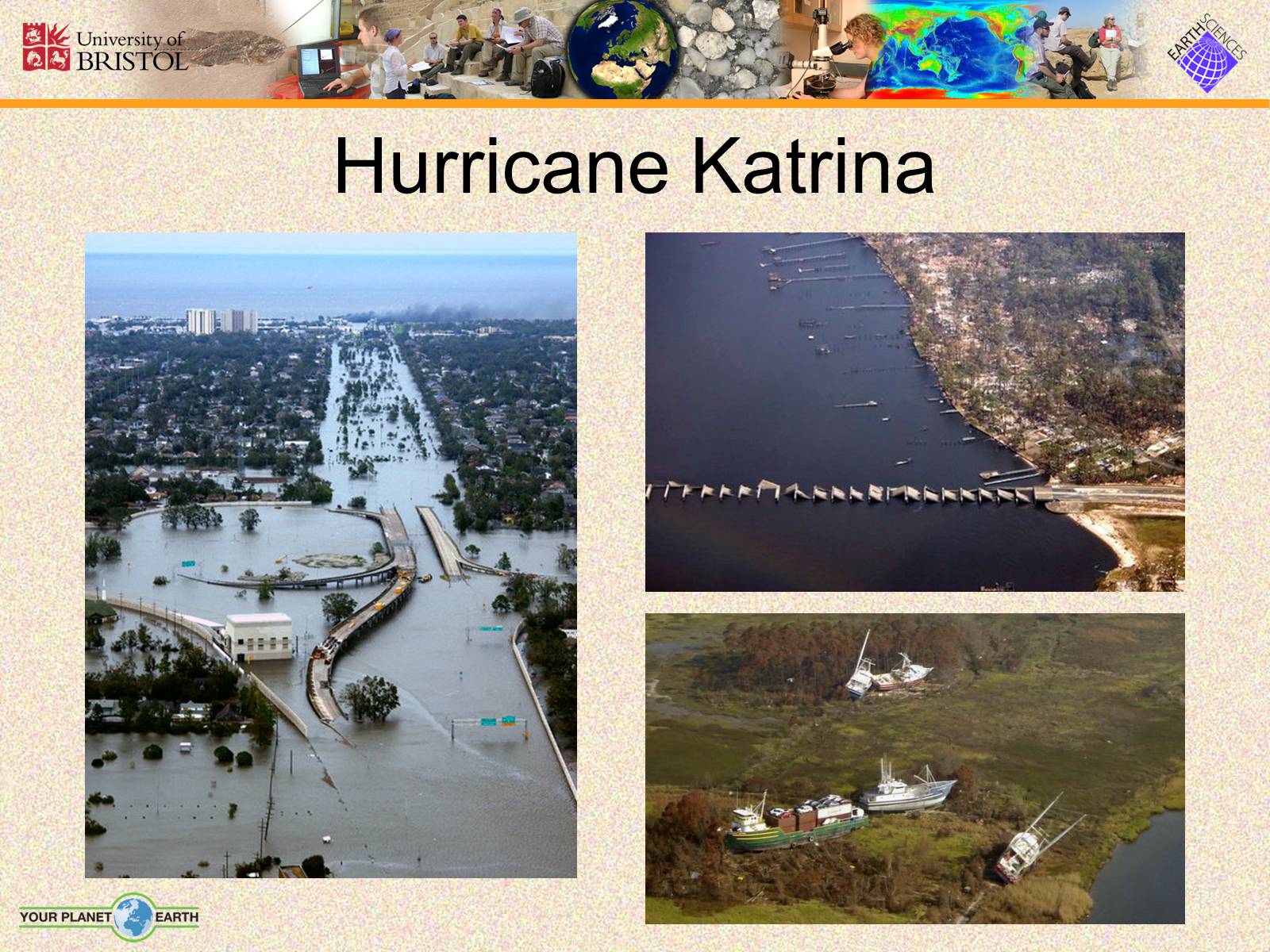
Слайд #26
What damage is produced?
Storm Surge
water that is pushed toward the shore by the force of the cyclone winds.
Storm Surge
water that is pushed toward the shore by the force of the cyclone winds.
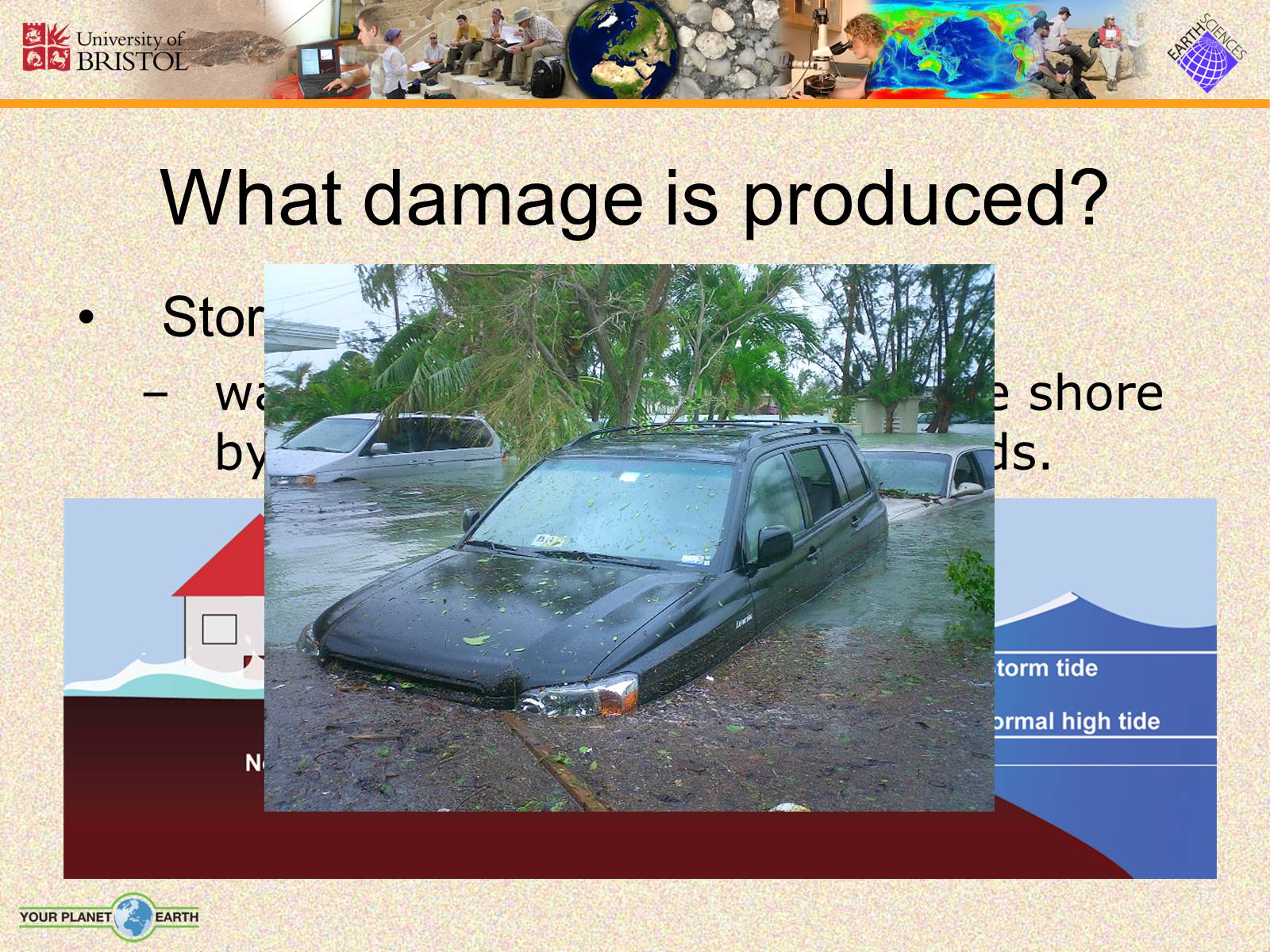
Слайд #27
What damage is produced?
Wind
responsible for the loss of power and utilities
wind damage affects larger areas than surge
flying debris
tree loss
Wind
responsible for the loss of power and utilities
wind damage affects larger areas than surge
flying debris
tree loss
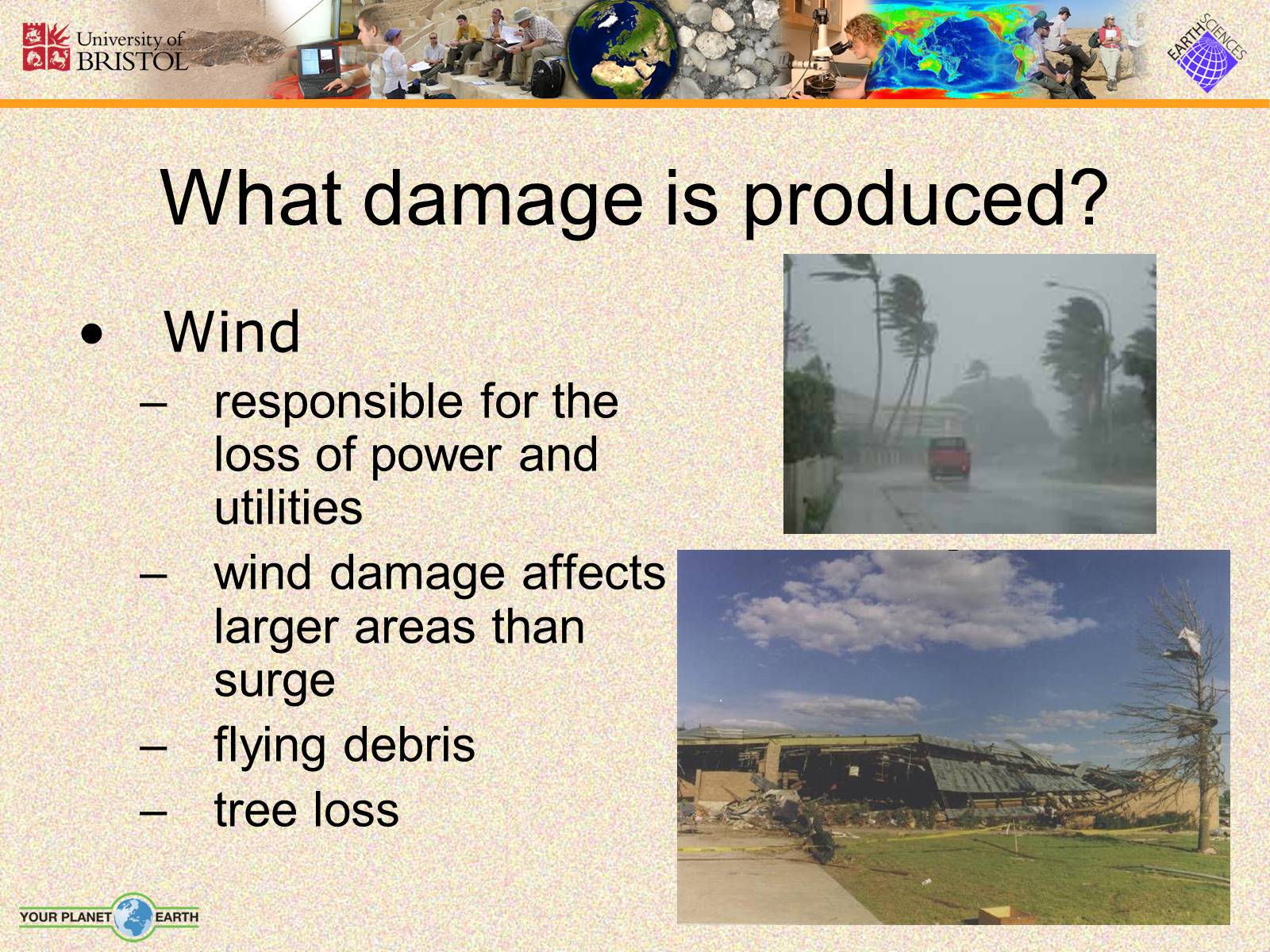
Слайд #28
What damage is produced?
Flying debris
debris propelled at high speeds
Flying debris
debris propelled at high speeds
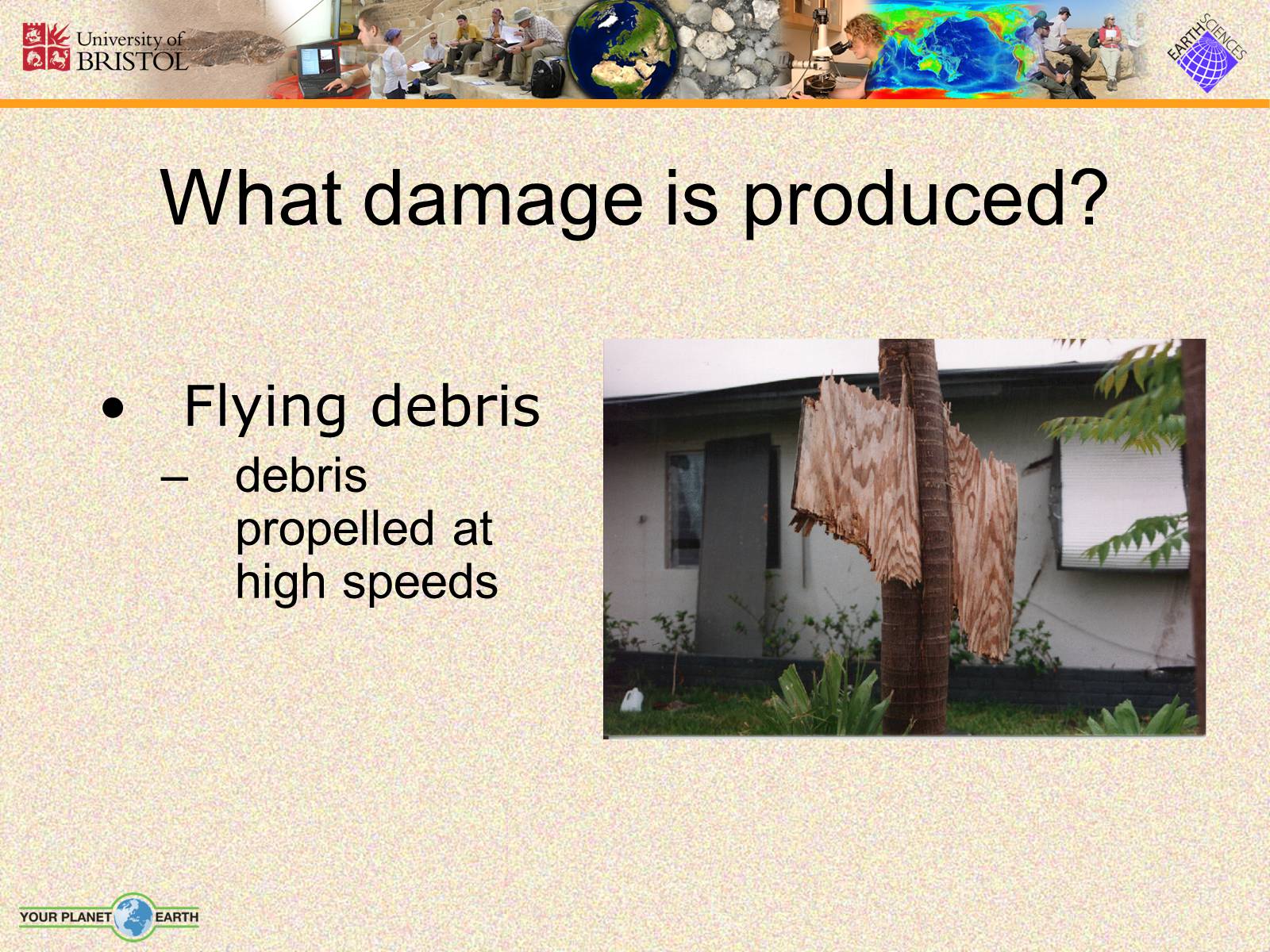
Слайд #29
How do we mitigate the hazard from a cyclone?
Monitoring
early warning systems
Infrastructure
cyclone walls
communal shelters
Education and planning
Monitoring
early warning systems
Infrastructure
cyclone walls
communal shelters
Education and planning
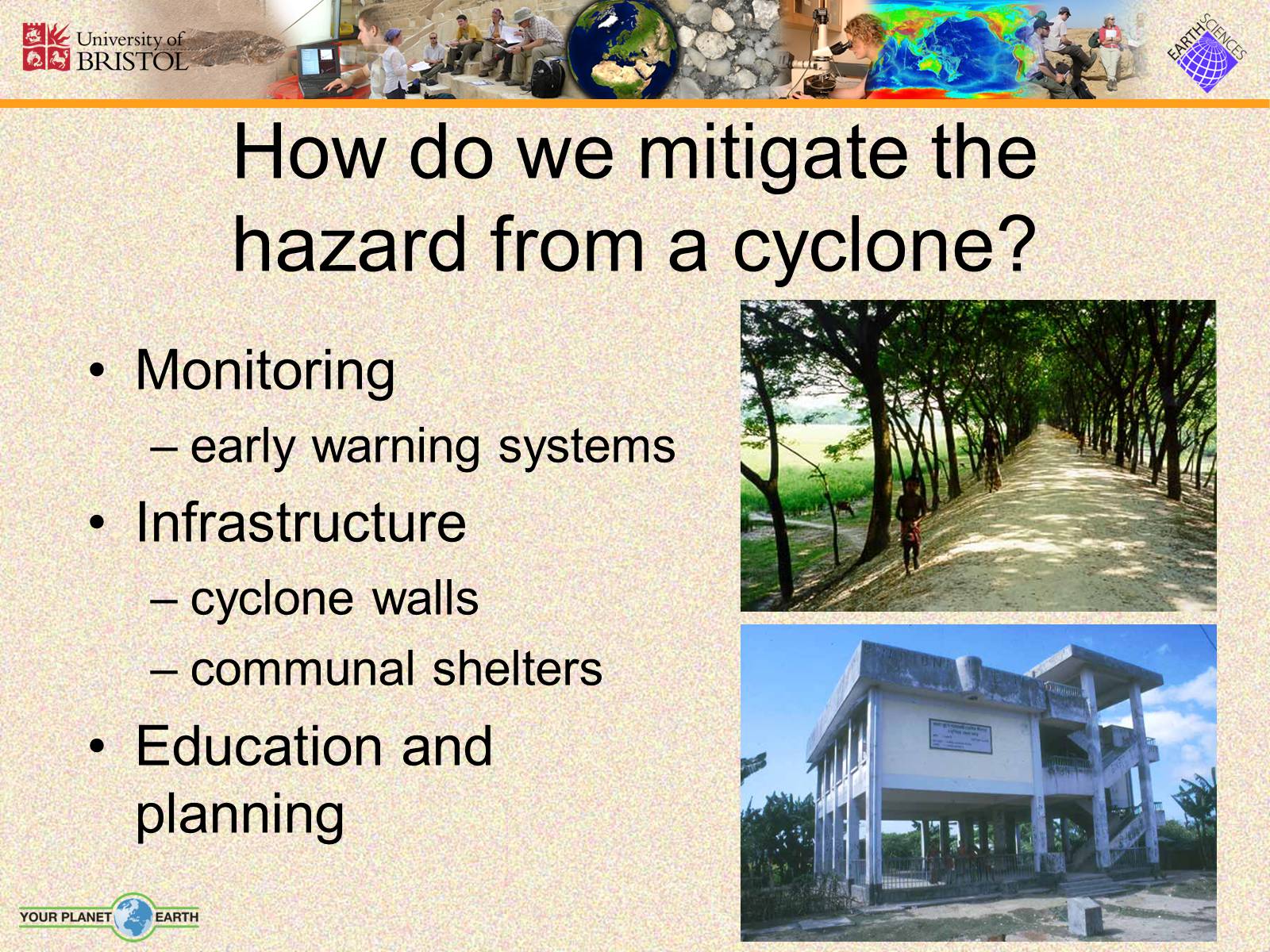
Слайд #30
Natural Hazards Summary
Graph showing the number of deaths per year due to natural hazard events
Graph showing the number of deaths per year due to natural hazard events
